#also its set in america during the great depression :3
Explore tagged Tumblr posts
Text

vamp x vamp hunter au that’s been infecting my brain
#deathnote#teru mikami#stephen gevanni#mikavanni#sorry if its scary LOL#can u guys see where im heading w this…*twirls finger in hair*#mikami as a vamp would target the bad guys me thinks…#also its set in america during the great depression :3
20 notes
·
View notes
Text
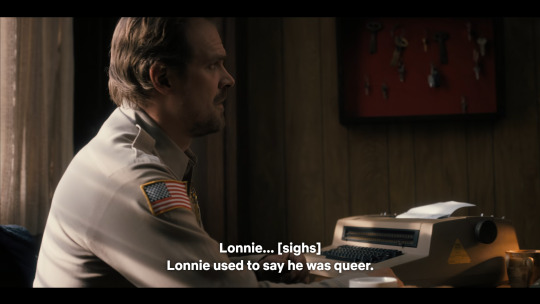
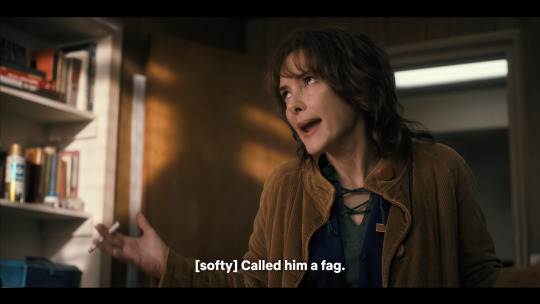
still thinking about this
tw ; talks about gun violence, racism and homophobia
I love everything our community has done and all the work that has gone into analysis, but you dont need a 300-something slide goodledoc to prove there's something going on here.
They talk about wills sexuality in the first episode, going so far as to use what is now a slur to describe him.
"oh but, lizbet, it was the 80s, it wasn't a slur then" I'm aware, but every film/show/book/play that is written in a different time period than the one it is set still has to be relevant to the audience it was made for. A lot of people think stranger things is set in the 80s to call back to classic thrillers like IT and ET, which it is...at its very basic, fundamental sketches. If that was all it is, the GA and younger watchers especially would not care for it as much as they do.
Anyone who ever read 'An Inspector Calls' in school should know what I mean. In 'An Inspector Calls', he author writes about the ignorance of an upper class 1912 family living in capitalist England through the context available to a 1947 audience. The audience knows the family faces two upcoming world wars, the titanic sinking and the great depression, this knowledge is used to highlight the ignorance of the family by believing England, and they too, are free from mistake or flaw. This dramatic irony screams out at you as you are watching/reading it. the typical audience doesn't scrutinise every detail, despite if those details are intentional.
"what makes stranger things relevant?" I hear you ask. "what context do we have that enhances the storytelling?"
Rising Russian-American tensions - Russians weren't actually shown as a threat in the show until season 3. Before then, it was pure paranoia from the US government in the show that fuelled their research and experiments, as the show is set during the cold war, it is relevant for the time period. The show reflects real life tensions as they've spiralled out of control due to the Russo-Ukrainian war through the actual introduction of Russian villains. (I think its common knowledge that the USSR were not actually opening interdimensional portals underneath 80s malls.)
The opening scene of season 4 showing the massacre of the lab children, children we'd seen innocently playing in the rainbow room. 010 we see taking a 'lesson' with Dr Brenner, the interaction is calm and the two joke. Moments later, every single one of those children is murdered. we hear sirens, screaming, and gunshots. The US in 2022 saw 51 school shootings. Gun laws in the US are a topic that a lot of people still do not want to address, but through stranger things, the writers force forward the reality of modern America in a way impossible to ignore. The reality that the leading cause of death in American children and teens is gun violence. The reality that an estimated 4.6 million american children live in a home where a gun is kept loaded and unlocked. The reality that, on average, 23 children are shot in the United States every single day. It's also the idea that it was the forced conformity of Henry Creel that pushed him towards this warped perception of humanity, allowing him to justify his actions. Reflecting the cases in which the shooter was a bullied student. Forced conformity being a core theme of the show, because it is relevant.
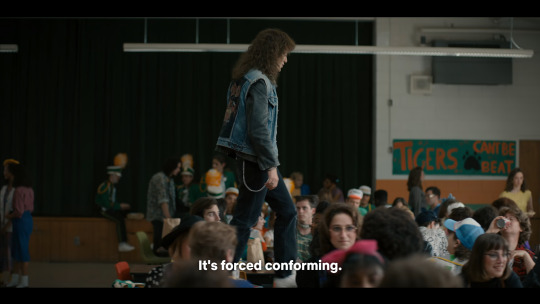
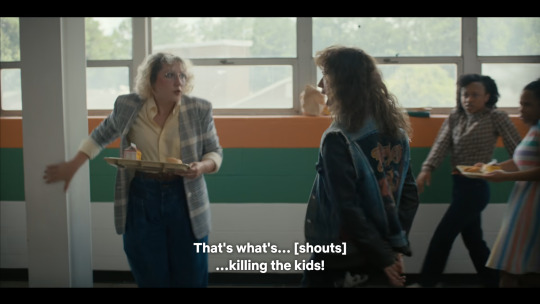
Constant reminders of a racial divide and aggression towards black characters, a theme that has persisted throughout the seasons much like it has persisted in real life.
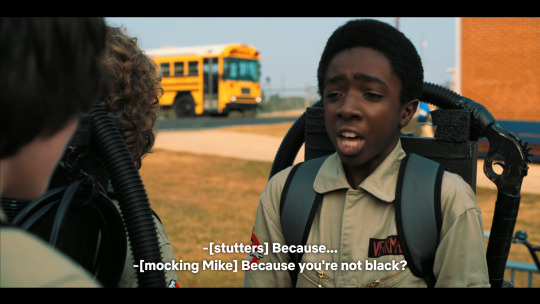
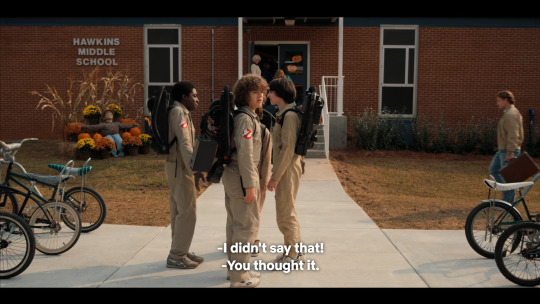
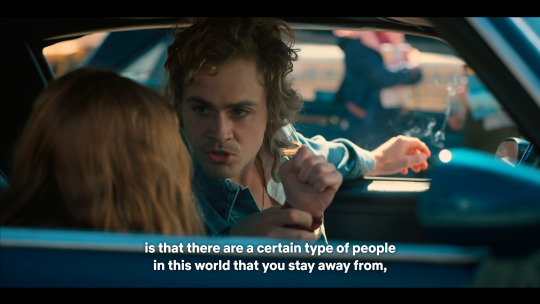
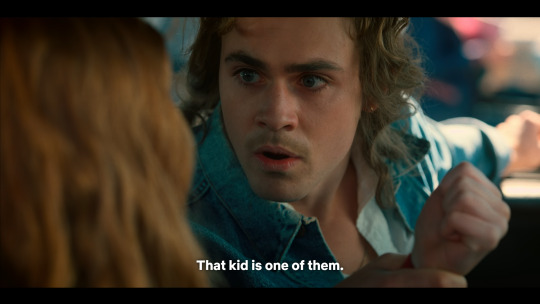
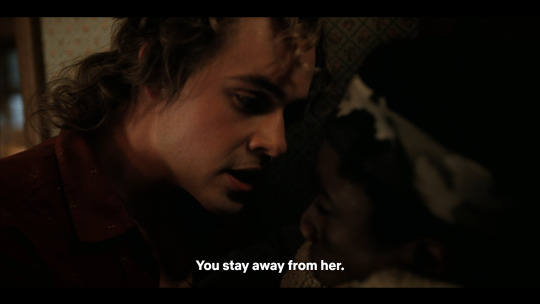
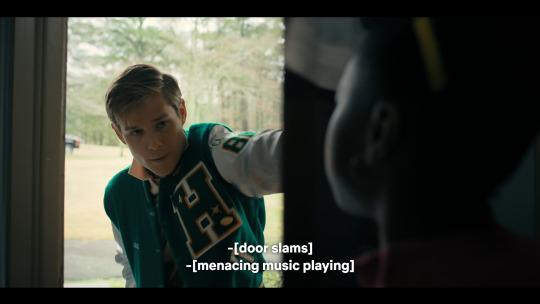
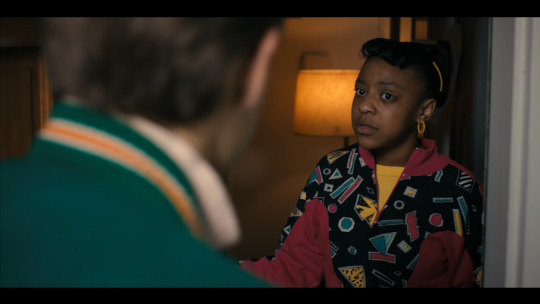
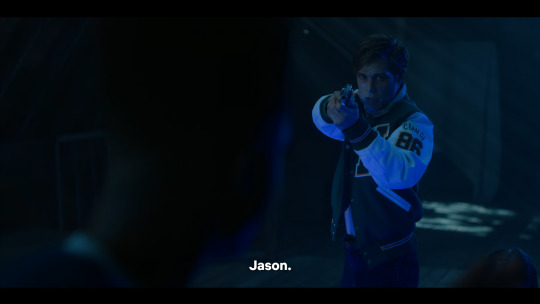
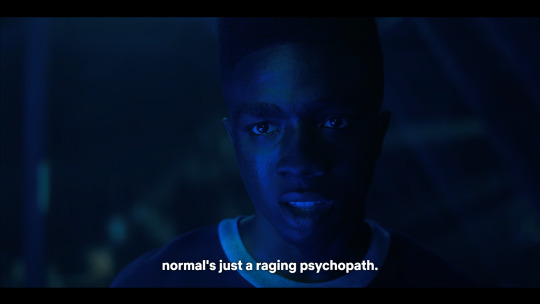
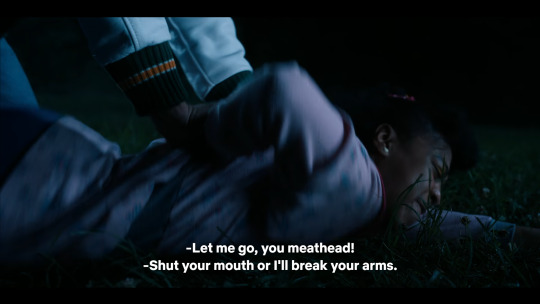
Growing LGBT acceptance
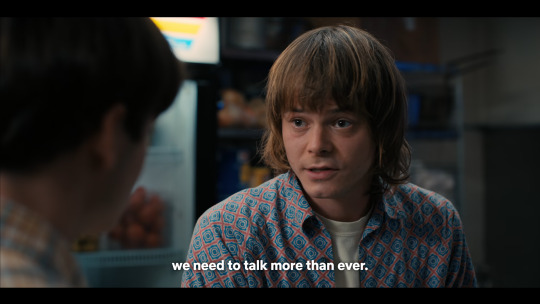
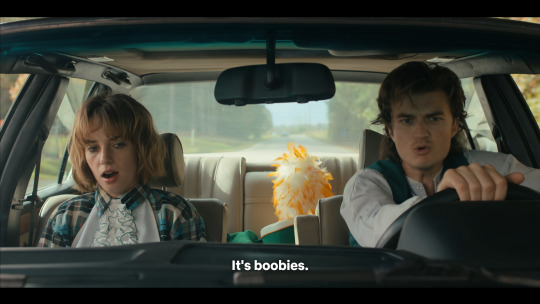
That's all I can come up with at the moment, I'm really eager to hear other peoples ideas on this, but moving on.
Each of these themes can be traced back to the very first episode.
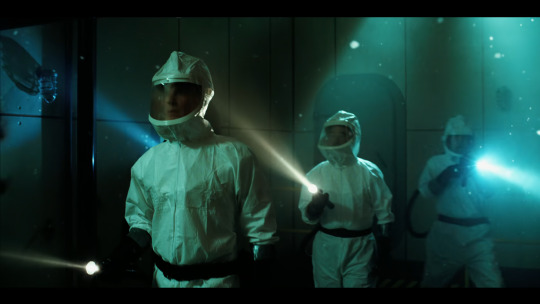
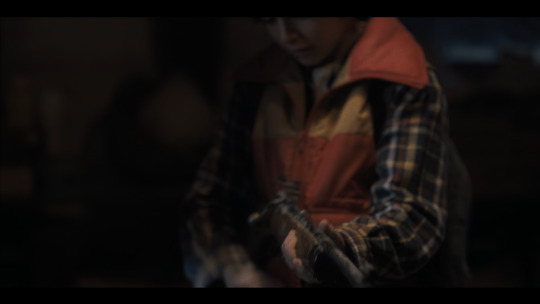

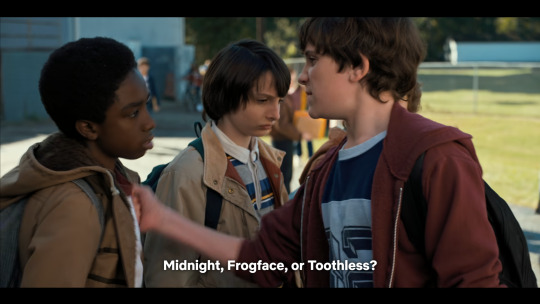
and then we have



If you think this is far fetched, consider how you'd write the first episode of a multi-seasonal period piece to introduce ideas and themes relevant to your audiences.
Consider how the recent legalisation of same-sex marriage in the US would impact your choices.
For the purpose of portraying Will as a reserved kid for which it is unusual for him to not have come home, it would have had the same effect for Joyce to stop at the fact he is made fun of at school for his clothes and such.
this line adds a layer to her concern, that Will was targeted and hate-crimed, she is trying to get the police involved. What does Jim do?
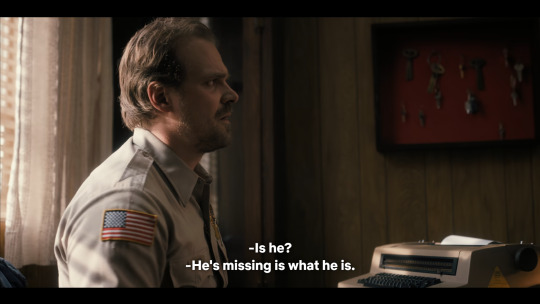

He expresses judgement.
There is no reason to include this other than to lay the groundwork for a theme that will come back later in the show.
A theme that did come back and slapped us all in the face.
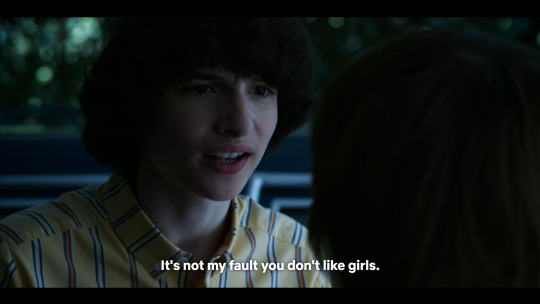

A theme that didn't go away like a lot of people wanted it to/assumed it would.
Assumed it would go away because so many shows nowadays drop a label or a flag pin on a character and leave it at that. It's frankly humiliating how people stoop so low to kiss the feet of writers who reduce them down to a few stripes. (most prominent example to me is Sasha Waybright's pitiful bi sticker in the last 3 minutes of the final episode that got people screaming in excitement.)
If this were the Russian-American tensions theme, it would be unusual to drop it before the shows concluding season, its core to Elevens storyline and the interactions of the main cast with ignorant government officials.
People have grown accustomed to the representation of queer characters with labels, that representation is the co-existance of hetero and homo characters without ever needing to address the differences. But we are different, its the beauty of being different that is ignored. I feel quite a lot of representation nowadays fails to reflect the core of LGBT experiences - love.
It is the love that makes us who we are, not the labels.
This is what makes Stranger things worthy of recognition, the queer characters are introduced through their love for others, not a single label is needed, they actually make a point of not labelling a single sexuality, which a lot of people mistook for them "dancing around the topic".
You think, for even a moment - with a style of queer storytelling such as that, that Wills love is going to be used to fuel the heteronormative relationship?
Stranger things - the show about being different, about love conquering hate - wouldn't go so far as to let Mike return that love?
yeah, right.
(i would like to add that these themes are serious issues i'm grateful the writers address. this post isn't meant to prove byler endgame, but the impact a requited love between them would bring to audiences and why that is important, much like the other themes.
the only way to have the full impact is for this theme to persist another season and play a crucial role to the shows conclusion, hence why Mike and Will are likely centre stage, even if they dont "get together", their bond is crucial to the plot, whatever happens with them and rovickie will be unforgettable.)
#mike wheeler#will byers#byler#byler parallels#stranger things 5#rambles#queer community#queer rep in media#queer representation
83 notes
·
View notes
Text
Chapter 1: Take the Head
You remember Pa teaching you how to pop the head off of a chicken. You weren’t very big yet, maybe five. You had always been taught to treat the animals with respect, so it jarred you to yank the chicken up by the throat. The chicken flapped and kicked; the golden eye latched on yours, a panicked pinpoint.
You couldn’t break her neck. You tried and you tried but you just rubbed her throat in a circle over and over like you were trying to give her an Indian burn. She frantically scratched your arm up and down, her beak gaping in a terrified pant. You know now that you could have done it easily—a chicken’s spine is little more resistant than a dry stick or a pencil—but that was just the problem: she wasn’t either of those things.
Then Pa took her from you, wrapped his fist around the throat, and popped the head clean off. He held the head out to you. The eyes had closed. The lids were soft and pink. Her face was peaceful. Her body still kicked.
“See?” he said. “Easy. She didn’t feel a thing.”
There was blood on Pa’s hands. When he pointed out the cockerel for you to try again, there was blood on your hands, too.
** You aren’t much of a conversationalist. You’ve gone on dates where you barely spoke a word. Your coworkers don’t know your name. You work in a factory line, screwing in one piece at a time. Dull work, monotonous work. Lets your brain run on its own time at its own pace.
You like to remember lists during such times. Pa taught you about something called a “mind palace,” a detailed map you build in your mind and store thoughts inside of. Somehow recall is easier when you can imagine them in a physical space. You store your shopping lists there. You also store guns—lists about makes, models, ammunition.
Guns have been a special interest of yours since childhood. You would save pages out of the Sears catalog as a child and tape them on the wall so you saw them when you woke up. You were fascinated how they went together and would draw them in their disparate parts before drawing them put together again. You liked drawing them from all different angles just to admire the geometry. You checked out books on guns from the library so often that the librarian started setting aside new offerings for you. You had never been able to own guns of your own, but you practiced with your father’s Mark I Sturm Ruger and the old .22. You could ping prairie dogs like a pro.
You like to think that eventually, you’ll buy one of your own. You know just the model—the BAR, or Browning Automatic Rifle—full-aut, carried by Bonnie and Clyde, running second-fiddle to the M1 Garand throughout World War II. When you repeat the gun list, you think “BAR” before any of the others; it is the highest honor you can bestow.
You like monotony for the same reason you like lists. There’s something relaxing about rhythms. It’s like music, like dance. You can’t dance, of course—you never learned. You don’t own a record player, either—you don’t spend money on frivolous things. The Depression is still a heavy black cloud in the back of your mind. You lived on a farm, so your belly never went empty, but you also didn’t grow up wearing shoes.
You are 28. Or is it 29? It’s been a while since you’ve thought about your birthday. It’s on July 3. “Our independence baby,” someone said. It may have been Pa, but you don’t remember exactly; you were very small. You do remember Ma replying that it was one day off and they weren’t in America anyway, so it didn’t count. You were disappointed for some reason; sure, you know it doesn’t make a difference either way, but it would be nice to have something special that was just your own. Oh, Ma and Pa told you you were going to do great things someday—that’s something you could believe when you were, say, eight. But then you had to make your way in the world and all the world offered was a factory line, a small dark room, and the weather. It’s hard to believe in anything magnificent at the bottom of a hole.
**
You live in sparsely-furnished rooms in cheap apartments near the ocean. On weekdays, you make your bed, eat breakfast (eggs, toast, coffee with cream), shave, dress, go to work (screw, screw, screw), come home and turn on the radio (evening news, then whatever entertainment strikes your fancy, usually action and adventure programs), drink a beer while completing the evening ablutions (wash dishes, pack lunch for tomorrow, shower, set alarm clock, read evening edition in bed until you get tired).
Sometimes you go to your neighbor’s to watch their television in exchange for a beer; you sit side by side and quietly drink as Lucy gambols and the laugh track rolls. On Saturdays, you go shopping for the household essentials and stand in lines while the grocer bags produce and the butcher cuts your lunch meat.
If it’s nice enough, you walk down to the ocean to stretch your legs. It’s not a pretty place by any means; a sodden gray beach where colorless rushes thrust insistent heads and sun-bleached shells lie. In winter, it’s even more dreary; the Atlantic is a sullen gray sweep and the nasty cold steals your breath. It’s the kind of cold that makes you feel wet and heavy even if you haven’t touched water.
You have never felt as though the sea is a nice place; you distinctly remember deciding this back when you first entered the town. Even in the summer, when the water is glassy green and the beach crowded with tourists, you feel as though the sea is a vast and apathetic monster—apocalyptic in size, in scale, in potential. Apocalyptic: you don’t go to church, but that’s the word that comes to you. The sea feels as though it should be the focus of worship, the kind of thing you sacrifice to; you’ve never held much by spiritual claptrap, but you will grant one place worthy of godhood.
You did not grow up near the sea. You grew up in Kansas, a land so flat you used to roll up papers like spyglasses and try to see Japan. You moved to the coast of New Jersey because you’d wanted to see the ocean. No—no, it may well have been because of the factory job. They do pay well and they probably printed something in the help ads. A family friend in New York often sends newspaper clippings with his letters just to be of service. Yes, that would make a great deal more sense: “I heard Jack is looking for a job,” he’d say. “Here are some local ones that are right up his alley.”
Yes, now that you think about it, that’s exactly what happened. The sea was a bonus—until you saw it. But how were you to know what the sea was really like until you went there? It’s too bad someone couldn’t have told you.
Sometimes you think you should move away, but learning new routines is such a pain that you just put up with it. Someday you’ll probably get tired enough to leave. The way the cold weaponizes itself with humidity tires you down to your bones.
You know, you haven’t thought of the family friend in a while. What was his name again? Joe? Jim? John? One of those common names. You’ll have to check your address book. It’s been a while since you’ve heard from him. You should write sometime to make sure he’s all right.
For that matter, you haven’t heard from your parents. When did they last write? Hell! Maybe it’s your turn to write. Yes, it’s your turn to write for certain; that would explain why you haven’t received any letters recently. You do tend to forget minutiae with the humdrum flow of everyday life. Your parents are older now; you know better than to leave them without a word every now and then. Your mother must be worried sick.
You decide to purchase some stationery and stamps that weekend, but you forget until the invitation comes, and by that time, it’s far too late. You didn’t know that then, of course. You didn’t know much of anything, if you have to be honest.
UPRISING: BLACK SCRAPBOOK HUB
#bioshock#fanfiction#jack wynand#vvatchword#uprising#part iv#chapter 1 first section#first draft subject to change#been hamstrung by video game mechanics because while in-game they make a lot of sense in-literature it sounds like a video game#another big challenge is to make it stand out in a horde of similar attempts and give it unique concepts that make it a worthwhile companion#big theme in uprising is bodily autonomy and how it is one of the most essential parts of human experience and yet so commonly reviled#kill yourself any number of ways but don't you dare fucking live#ive written some brutal shit before but this is going places my bitches
9 notes
·
View notes
Text
What songs about trains are used in movies?
Trains have always been a powerful symbol in storytelling, representing movement, change, freedom, and sometimes loss or nostalgia. From the rhythmic chug of the wheels on the tracks to the evocative sound of a distant whistle, trains often embody the themes of a character’s journey, both literal and metaphorical. These motifs are especially prevalent in music, and songs about trains have become an iconic part of movie soundtracks, adding depth and emotional resonance to cinematic scenes.
In this blog post, we’ll explore some of the most memorable songs about trains that have been used in movies. These tracks are more than just background music; they help to tell stories, evoke emotions, and enhance the visual narrative on screen. Whether you’re a fan of classic films or modern blockbusters, chances are you’ve encountered these iconic songs. Let’s dive into the world of cinema and discover how About Trains Songs have enriched the movie experience.

1. "Mystery Train" by Elvis Presley – Used in Mystery Train (1989)
One of the most famous songs about trains is Elvis Presley’s “Mystery Train”, a rockabilly classic originally recorded in 1955. The song itself is about a train that symbolizes both loss and freedom, with the lyrics capturing the haunting feeling of waiting for a train that never seems to arrive.
"Train I ride, sixteen coaches long, Well that long black train got my baby and gone."
The song was memorably used in Jim Jarmusch’s 1989 indie film Mystery Train, which takes its title from Presley’s hit. The movie is structured as three separate stories, all set in Memphis, Tennessee, with the train serving as a thematic undercurrent connecting the characters. Elvis Presley’s influence is felt throughout the film, but “Mystery Train” plays a pivotal role in establishing the tone of longing, loneliness, and the mystical allure of travel.
Presley’s song perfectly complements the film’s themes of waiting, separation, and the passage of time, making it a prime example of how train songs can deepen a movie’s emotional impact.
2. "City of New Orleans" by Arlo Guthrie – Used in Bound for Glory (1976)
“City of New Orleans”, written by Steve Goodman and performed by Arlo Guthrie in 1972, is one of the most iconic songs about trains in American music. The song tells the story of a passenger train traveling from Chicago to New Orleans, with vivid descriptions of the journey and the people on board.
"Good morning, America, how are you? Say, don't you know me, I'm your native son, I'm the train they call the City of New Orleans, I'll be gone five hundred miles when the day is done."
The song was used in the 1976 film Bound for Glory, which tells the story of folk singer Woody Guthrie (Arlo’s father) during the Great Depression. In this context, the song serves as a nostalgic reflection on the passing of time and the decline of the American railroad system. The use of “City of New Orleans” in the movie reinforces the idea of trains as symbols of movement, progress, and change, while also highlighting the fading grandeur of rail travel in the 20th century.
3. "Folsom Prison Blues" by Johnny Cash – Used in Walk the Line (2005)
Johnny Cash’s “Folsom Prison Blues” is perhaps one of the most famous songs about trains in music history. First recorded in 1955, the song tells the story of a man who is imprisoned and longs for freedom as he hears the sound of a train passing by.
"I hear the train a-comin', it's rollin' 'round the bend, And I ain't seen the sunshine since I don't know when..."
The song was prominently featured in the 2005 biopic Walk the Line, which chronicles Cash’s life, his rise to fame, and his struggles with addiction and personal demons. In the movie, “Folsom Prison Blues” is used during the pivotal scene where Cash performs the song live at Folsom Prison, capturing the raw emotion and rebellious spirit that made Cash a legend. The train in the song symbolizes both freedom and the unattainable, making it a perfect fit for a movie about a man trying to break free from his own personal prison.
4. "Train Kept A-Rollin’" by The Yardbirds – Used in Blow-Up (1966)
“Train Kept A-Rollin’” is a blues song originally written by Tiny Bradshaw in 1951, later popularized by bands like The Yardbirds and Aerosmith. The song has a driving, relentless rhythm that evokes the unstoppable motion of a train, making it a perfect fit for high-energy scenes.
In Michelangelo Antonioni’s 1966 film Blow-Up, the Yardbirds’ version of “Train Kept A-Rollin’” is used in a chaotic concert scene where the protagonist experiences a disorienting blend of sound and movement. The train song’s frenetic energy mirrors the protagonist’s growing sense of unease and confusion, with the relentless rhythm of the track capturing the film’s theme of disillusionment. The song’s use in this iconic film further cemented its status as a classic rock anthem and a quintessential song about trains.
5. "Love in Vain" by The Rolling Stones – Used in The Departed (2006)
Originally written by blues legend Robert Johnson in 1937, “Love in Vain” is a haunting song about heartbreak, with the train symbolizing the departure of a loved one. The song was famously covered by The Rolling Stones in 1969, adding a rock and blues twist to the original.
"When the train left the station, it had two lights on behind, The blue light was my blues, and the red light was my mind."
In Martin Scorsese’s 2006 film The Departed, the song is used in a reflective moment that emphasizes the themes of betrayal, loss, and longing. The train in “Love in Vain” symbolizes the irreversible passage of time and the pain of watching someone leave your life for good. Scorsese’s use of this song adds emotional weight to the film’s portrayal of divided loyalties and doomed relationships.
6. "Train Song" by Vashti Bunyan – Used in The Parent Trap (1998)
“Train Song” by British folk singer Vashti Bunyan is a delicate, acoustic track that uses the imagery of a train journey to tell a story of love and separation. First released in the late 1960s, the song has a gentle, dreamlike quality that makes it perfect for quiet, introspective moments in film.
"Travelling north, travelling north to find you, Train wheels beating, the wind in my eyes..."
The song was used in the 1998 remake of The Parent Trap, starring Lindsay Lohan. In the film, the song plays during a key emotional scene, heightening the feeling of nostalgia and longing as the characters are separated by distance. The tender tone of “Train Song” perfectly complements the film’s themes of reunion and family.
7. "Last Train to Clarksville" by The Monkees – Used in Head (1968)
“Last Train to Clarksville” is a 1966 hit by The Monkees that tells the story of a man asking his lover to meet him at the train station before he leaves for war. The upbeat, catchy melody contrasts with the song’s underlying theme of separation and uncertainty.
"Take the last train to Clarksville, And I'll meet you at the station..."
The song was used in The Monkees' 1968 film Head, which was a surreal, experimental movie that defied traditional narrative structures. “Last Train to Clarksville” provided a sense of energy and nostalgia within the film, echoing the themes of fleeting moments and missed opportunities. The song’s use in Head showcases how a seemingly lighthearted train song can carry deeper emotional undertones when paired with the right visual narrative.
Conclusion: The Power of Train Songs in Film
Trains have been a recurring symbol in music for over a century, and their presence in film is just as enduring. Songs about trains evoke a wide range of emotions—freedom, longing, escape, and even danger—making them the perfect companion for cinematic storytelling. From Elvis Presley’s “Mystery Train” to Johnny Cash’s “Folsom Prison Blues,” these songs help shape the mood and themes of the movies they’re featured in.
If you’re interested About Trains Songs in cinema, these tracks offer a glimpse into how filmmakers use the power of trains and music to deepen emotional resonance and add layers of meaning to their stories. Whether capturing the spirit of a journey or the heartache of watching someone leave, train songs will continue to play a vital role in the world of film for years to come.
0 notes
Text

9 real-life horror stories of people who disappeared and were never found
Tales from the Charley Project highlight strange disappearances from an older, eerier America.
The most terrifying stories out there are often true. And the best versions of those are the ones where the answer can never truly be known. Why else do Jack the Ripper and the Zodiac Killer occupy such outsize places in our collective unconscious?
13 classic scenes that explain how horror movies work
The Charley Project is a database that catalogs people who have disappeared without a trace. The site is a great resource and repository for modern cases, but if you look at its database chronologically, you will find cases from far earlier in the 20th century that will likely never be solved, simply because all involved have passed away.
It’s these cases — from an older America where a disappearance was less likely to turn into a mass media sensation — that haunt the memory the most. They’re a record of a time when so-called “stranger danger” wasn’t a well-known topic, or when a woman could run a business selling kidnapped children to the rich.
Here are a handful of the best historical disappearances contained in the Charley Project’s archives.
1) The Martin Family (Oregon, 1958)
Some of the best details in stories like these have to do with the lives of people the disappeared left behind. What actually happened to the Martin family isn’t much of a mystery — they likely drove off the road on the way home, their car plunging into the river below — but the evocative snapshots of a life never resumed make this entry particularly eerie. It highlights all the mundane details of life that might flash before your own eyes in the instant everything changes.
2) Bobby Dunbar (Louisiana, 1912)
Fans of This American Life will recognize this story, as it was the center of one of the show’s best episodes. When young Bobby Dunbar, just 4 years old, wandered off from his family on a group outing, he was never seen again. It’s possible he fell from a railroad trestle and drowned. It’s also possible he was abducted by a “strange man” who was seen lurking in the area. But we’ll likely never know, because authorities thought they found Bobby Dunbar — and didn’t realize it was another child entirely (who simply stepped into Bobby’s life) until 2004, long after it would have been possible to solve the case.
3) Billy Gaffney (New York, 1927)
When 4-year-old Billy Gaffney was left to play with a 3-year-old friend in the hallway of his Brooklyn apartment building for just a few moments, the two boys disappeared. The 3-year-old was eventually found on the roof of the apartment building, and he said the “boogey-man,” an elderly gentlemen with a gray mustache, had spirited Billy away. Serial killer Albert Fish (who fits the boogey-man description) confessed to Billy’s murder years later, but Billy’s remains have yet to be found.
4) Mary Moroney (Illinois, 1930)
Mary Moroney, just 2, is an example of a recurring motif in the Charley Project’s archives: families desperate for cheap child care during the Great Depression who simply trusted the wrong person. Moroney disappeared after her parents allowed her to spend a day with a woman who called herself Julia Otis. A woman purporting to be Otis’s cousin later wrote to the family to say Otis was “love hungry” after the loss of a husband and child and that she would care for Mary. Mary has never been found and would be in her 80s today. She may still be alive and have no idea who she is.
5) Georgia Weckler (Wisconsin, 1947)
The sad story of the disappearance of Georgia Weckler, 8, is haunting for one specific reason: “Curiously, prior to her disappearance, Georgia had made several remarks indicating that she especially feared being kidnapped.” What prompted this, we’ll likely never know.
6) Evelyn Hartley (Wisconsin, 1953)
The disappearance of Evelyn Hartley is straight out of a horror movie. The teenager was babysitting one evening when she didn’t call to check in with her parents at the appointed time. Her father went to check on her and found a completely locked house with the lights and radio still on — and no Evelyn inside. Signs of a struggle and forced entry led to a desperate search for the girl, but she was never found. Pools of blood that may have belonged to Evelyn, as well as eyewitness accounts of a girl who might have been her, make this story all the more mysterious.
7) Bruce Kremen (California, 1960)
Bruce Kremen disappeared while attending camp. He was playing with a few other boys just a short distance from his group, when he became separated from them and was never seen again. Initially believing him to be lost in the San Gabriel Mountains, authorities mounted a massive search, but were unable to find either the boy or his remains. Now, however, authorities believe him to have come in contact with Mack Ray Edwards, one of America’s least known yet most prolific serial killers, who worked on highway construction and perhaps buried the remains of his victims beneath the asphalt, where they would never be found.
8) Marjorie West (Pennsylvania, 1938)
The West family went out after church for an outing in the country, one that involved Marjorie, 4, and her 11-year-old sister going to pick wildflowers. The sister went to talk to their parents, and Marjorie disappeared from the middle of a wide-open field. This might seem like a standard-issue kidnapping story save for the fact that Marjorie’s life might well have intersected with Georgia Tann, the woman who ran the Tennessee Children’s Home Society. Praised for her ability to find homes for children who needed them, Tann actually abducted more than 1,200 children and then placed them with rich families in far-off states like California — often for a hefty fee. If Marjorie did somehow meet Tann or someone who worked with her, she could be alive today and unaware of her true identity.
9) The Sodder children (West Virginia, 1945)
By far the eeriest story in the Charley Project archives is that of the five Sodder children, who all disappeared under suspicious circumstances on Christmas Eve night. The children (five out of 10 siblings) asked their parents if they might stay up and play with their new toys, rather than go directly to bed. Their parents agreed and turned in for the night, and a series of strange events transpired.
First, the phone rang, the children’s mother answered, and the voice on the other end asked for someone the mother had never heard of.
When she said so, the voice laughed and hung up. The mother later realized all of the lights in the house were on, the shades were drawn, and the doors were unlocked. She awakened again by a sound on the roof, and then she woke up for the final time at 1:30 am with the realization that the house was on fire. She, her husband, and their other five children got out, but the five children who had asked to stay up late never emerged from the inferno. When their father went to climb his ladder up into their bedrooms on the second floor, he could not find it. It was later found dragged away from the house.
The official conclusion was that the children had died in the house fire, but the Sodders never stopped believing their kids were still alive, right up until the two parents died. And they were encouraged by a strange photograph mailed to them in the ’60s, purporting to show one of their sons as a grown adult. Did the Sodder children die in a fire set by never-caught perpetrators? Perhaps. But the tantalizing thought that they might have been kidnapped — might still, indeed, be alive, perhaps in Italy — has kept some sliver of hope that this strange case might find resolution.
#9 real-life horror stories of people who disappeared and were never found#paranormal#ghost and spirits#ghost and hauntings#haunted salem#myhauntedsalem
16 notes
·
View notes
Text
Art Deco and TAZ Graduation

- Episode 30 "Take your Firbolg to Work Day
I know Travis probably made his choice to have the H.O.G. headquarters be designed with Art Deco for aesthetic purposes and didn't think of its function to the world of Nua BUT his choice is a really great accidental component that adds onto the world building in Nua and to one of the core problems that Graduation addresses involving the systemic nature of Nua. In this essay, I-
(And then I proceed to actually write the essay hidden below. FAIR WARNING: This is extremely long. If you want to learn about Modern Art History and how it ties into Graduation, this is your lucky day.)
This analysis/essay is going to be meta in terms of using evidence from real world events but it is needed to explain the history behind Art Deco and help us relate to the themes of Graduation. I think it’s clear to see how the systems and people in power in Graduation are influenced from the way our governments are now so I don’t think these connections are distant, rather closer together than we think.
Also, before we continue, I want to direct you to this lovely post made by a dear user and friend, Michelle/ fitzroythecreator, LINK HERE
She explains what she believes to be a core theme of graduation that I agree with and have integrated into this essay. Check it out <3
Before I can explain how Art Deco is tied into Graduation's core theme, I need to lay out definitions and context to art movements in the early 20th century. Along the way, I will make connections to the world of Nua and how real-life events in the early 20th century actually can relate to Graduation and its worldbuilding.
Let’s address what is Art Deco. Art Deco started as an art and architecture movement during the early 20th century (1900s). Most people are familiar with its aesthetics of geometric designs and influence of industrialization because of the roaring 20s era and many media influenced by it. Do you wonder why it was popularized in the US? It’s because during the great depression in the US, public buildings, more importantly federal government buildings, were commissioned to have this aesthetic thus it would have more publicity and access to the public. The H.O.G. headquarters could easily be compared to this event because it shares similar attributes of being a public government building.
With this information, it would be really interesting to imagine the timing of Graduation being set around the early 20th century. Art Deco gives us a time period to compare what kind of social events Nua could have faced similar to the real world. The modern period of the 1850s-1950s was a time when people were disinterested and scared of the changes that industrialism made in their daily lives. People were frustrated with the changes made in their lives and sought out ways to cope with the changes through escapism. In Graduation, I would argue that we see this skepticism and wariness in the characters about the changes Nua’s Socioeconomic systems made in their lives and society in general. A good example would be the student NPCs and their insistence that their hero and villain titles are just labels since they have been stripped from their original meanings. They still somewhat criticize the structure while upholding it. As the campaign progresses, we meet various characters who are very critical to Nua’s current orderly system such as Order and Gordie. In fact, despite their roles in society being vastly different, they both share the same opinions that the system is unjust as it hurts people thus there needs to be a push for change. I am not trying to label the time of Graduation to be around the 1900s, rather whatever year Graduation happens is in parallel to the events of the 1900s.
When I first heard Travis say, Art Deco, I was interested but disappointed it wasn’t Art Nouveau. My original thinking was because of Art Nouveau’s elitism of making the architecture more artistic and complex that only educated rich people can understand and less functional for the average citizen. A lot of the art displays during the art movement were held in house museums that were limited to rich eyes. I thought this reasoning made sense in terms of the H.O.G. headquarters being this elite building common people can’t comprehend. However, with continuous thought, it clicked. Art Deco fits so well.
Art Deco was meant to be a direct response to Art Nouveau and the Arts and Crafts movement. (And many more but for the sake of simplicity, sticking to these two major ones) Both movements share similarities of the desire to make total works of art.
____________________________________________________________________________________________________________________
For art Nouveau in architecture, that is more on its aesthetics of stylized curving forms, thus it creates uniqueness with the architecture. For the Arts and Crafts movement in Europe, they focused on the importance of the craftsmanship and quality. The thing about the movement is that it’s heavily influenced by socialist values and the distaste for industrialism. Both art movements were diverse in style and locations globally. Because both took place internationally, there was no determined manifesto or structures for artists to adhere to. Another thing is both movements had lots of ornamentation which takes great skill and time to put into the works. By doing this, it would make the works more unique aspects to its character, however more time consuming and difficult to replicate.
Art Deco takes response to this because critics felt like these movements were outdated for the growing industrialism happening during the early 20th century. Art Deco focuses on sleek geometric design meant to be reproduced easily thanks to industries and have more emphasis on its function rather than aesthetics. It’s meant to be functional to accommodate for the new technologies of the 20th century.
So, let’s recap, in the late 19th century, two movements, focused on the style which had no concrete structures to adhere to and had the goal to make total works of art that is reliant on itself, are then replaced by Art Deco, a movement focused on its aesthetic to be mass produced easily and have a stronger focus on the form of the architecture to serve its functions. Does Art Deco sound similar to a number of Socioeconomic systems placed in Nua?
One of the key ideals of Art Deco is Functionalism. Art Deco is one of the many architectural movements in the early 20th century that decided to focus on function rather than aesthetics. What is functionalism? It is the idea that everything works as an integrated whole and that all the different components of a larger system are designed to work together. It is orderly. Architecture in the early 20th century was designed to suit the needs of the space. For example, each element of an office buildings would be designed and organized to suit that place. This ideal is more emphasized after the Great Depression in America where architects shifted their focus on the Streamline Moderne, where they aimed to make structures practical to the demands of real life and remove the emotional aspects of expressionist art.
Travis’s little choice to pick Art Deco is tied to a core theme of Graduation of dismantling the standards and structures set in Nua. It’s so brilliant yet unintentional. I know Travis hasn’t read up on modern art history. I hope by reading through, you can spot Art Deco’s need for creating limitation to focus on the functions and how it benefits the whole system. It doesn’t allow for the emotional aspects that Art Nouveau and the Art and Crafts movements held. Nua’s system follow the same thing. Everyone has a function in the socioeconomic system that has limitations meant to exploit the work labor and functions of the individual. The system leaves no room for indivduals to have growth to create real change. That’s not a flaw of the system. The system is literally designed to be that way with its many rules and standards. It's impossible to break away from it without being punished by the system itself. You need to function within its rules and have practical skills to contribute to the system. Your independent nature is stripped away. By having Art Deco be a core aesthetic design for the H.O.G. Headquarters, Art Deco ITSELF is just another element in the architecture meant to serve its function of upholding the ideology of order that H.O.G. and the world of Nua has. This orderly system has replaced the wild world that Higglemas in episode 12 remembers.
“I remember... the world when it was wild. Not sophisticated and ordered and... bureaucratic, like it is now.”
#taz graduation#taz grad#taz analysis#taz meta#vanitewrites#this is the art major part of me screaming out#modern art history is so interesting and fits so well into the history of Nua#Travis is not smart enough to think this deep for the aesthetics of the hog building#BIG THANKS TO MICHELLE#i still think about that post you made on the self reliance theme
82 notes
·
View notes
Text

Shang-Chi Shatters A Big Record As The Marvel Blockbuster Dominates The Box Office In Its Opening Weekend
In case you hadn't noticed, it's been a strange and often troubling time in recent weeks for movie studios to release big blockbuster titles. Rising numbers of the COVID-19 Delta variant has stunted box office potential, and it has resulted not only in subdued numbers, but we're also starting to once again see some notable upcoming features changing their release dates. Given this atmosphere, there has been a great deal of curiosity surrounding Destin Daniel Cretton's new Marvel movie Shang-Chi And The Legend Of The Ten Rings. Going into its theatrical debut, there were questions regarding how its performance would stack up within the legacy of the world's most popular franchise, and if it would meet the standard that has been set. Now we have an answer in the form of record-breaking Labor Day weekend ticket sales.
Check out the full Top 10 below!
1. Shang-Chi &The Legend Of The Ten Rings* $71,400,000 Total: $71,400,000
2. Candyman $10,550,000 Total: $39,063,370
3. Free Guy $8,719,000 Total: $91,893,081
4. Jungle Cruise $3,950,000 Total: $105,647,991
5. PAW Patrol: The Movie $3,695,000 Total: $30,019,661
6. Don’t Breathe 2 $2,210,000 Total: $27,990,920
7. The Suicide Squad $905,000 Total: $54,406,632
8. Black Widow $748,000 Total: $182,501,319
9. The Night House $552,000 Total: $6,297,926
10. The Protégé $525,000 Total: $6,891,230
As I noted in my column last weekend, the final weeks of August/early weeks of September are not seen as a goldmine for studios, as people typically have more things going on in their lives than seeing movies – and that goes a long way in explaining why the previous box office record holder for biggest Labor Day weekend was Rob Zombie's Halloween, which brought in $30.6 million on the holiday (Friday to Monday) in 2006. Of course, this year marks the first time that Marvel Studios has ever put out a new title in September, and their films have a history of upending what is considered normal. We'll have to wait and see what the final total is after audiences spend part of their day off tomorrow seeing the blockbuster, but obviously the $71.4 million already earned blows the previous #1 out of the water.
It's a wonderful albeit rare thing to see a film break a pre-pandemic record these days, though it should also be noted that Shang-Chi And the Legend Of The Ten Rings hasn't quite set mid-pandemic records. Instead, these opening weekend numbers mean that the film has to settle for second place when it comes to ticket sales since March 2020. It made enough money domestically to beat our Justin Lin's F9, which earned $70 million in its first three days in late June, but it fell just a tad short of the $80 million that fellow Marvel release, Cate Shortland's Black Widow, pulled in back in early July. As you can see, the latter is still hanging out with its franchise cousin on the Top 10.
As ever, it's definitely better too look at the performance of the new release in the context of other movies in the last few months, as the opening frame for Shang-Chi And The Legend Of The Ten Rings ultimately doesn't look all that impressive when you stack it up compared to all of the Marvel Cinematic Universe films going back to 2008. With its take, the film sits just outside the Top 20 opening weekends in the franchise, having made just a few million less than what Peyton Reed's Ant-Man And The Wasp earned in summer 2019. It does sit ahead of all of the non-Iron Man Paramount releases – including Kenneth Branagh's Thor ($65.7 million), Joe Johnston's Captain America: The First Avenger ($65.1 million), and Louis Leterrier's The Incredible Hulk ($55.4 million) – and also Peyton Reed's Ant-Man ($57.2 million).
What should also be noted is that Shang-Chi And The Legend Of The Ten Rings, unlike Black Widow, was not given a hybrid release by Walt Disney Pictures, and is currently only available to watch in theaters. This in mind, there are going to be a lot of industry eyes on how well the film performs next week. Black Widow notoriously saw its numbers drop off in a crazy way in its sophomore weekend, and much of the blame has been put on the fact that the movie was available to watch via Premier Access on Disney+ (the suggestion being that the majority of people not clamoring to see it opening weekend on the big screen were happy to settle for a viewing in their living rooms instead). Its performance could actually add an interesting wrinkle to the on-going lawsuit that Scarlett Johansson filed this summer, so be on the lookout for updates on that story.
Simu Liu as Shang-Chi in Shang-Chi And the Legend Of The Ten Rings
Unsurprisingly, no other studio dared try to put out their own new wide release to compete with Shang-Chi And the Legend Of The Ten Rings, and while that led to somewhat depressed box office numbers over all, the films from August are continuing to pull in money from theaters. At the front of the line is Nia DaCosta's Candyman, which only dropped 52 percent in its second weekend, and added another $10.6 million to its domestic haul.
You may remember that Candyman impressively overperfomed when it debuted, pulling in $22.4 million in its first Friday-to-Sunday, and it was able to still find a solid number of people to scare even while going up against a well-reviewed franchise juggernaut. The horror film has now made $39.1 million at the domestic box office, which means that it has surpassed the total made by Bernard Rose's original during its entire theatrical run in 1992 (though that doesn't account for inflation). With its $10.9 million take abroad, the release has eclipsed $50 million worldwide.
Two of the most impressive performers right now, however, are Jaume Collet-Serra's Jungle Cruise and Shawn Levy's Free Guy. Both movies have been around since the first half of August, and they are holding on tight to their respective spots in the Top 5. Neither release had crazy splashy debuts, as neither managed to make over $35 million in their first three days, but they've continued to bring in money while other new releases have floated down to the bottom of the chart.
When it comes to the conversation surrounding hybrid releases, Jungle Cruise has been a bit of an anomaly, as it remains available via Premier Access on Disney+, but it has continued to bring audiences to the big screen. Not only has it made $105.6 million in North America, but it has also earned $86.9 million from overseas ticket sales, bringing its global total to $192.5 million. That puts it on the worldwide Top 10 for 2021.
Free Guy, meanwhile, is doing even better. Like Shang-Chi, the video game-inspired Ryan Reynolds comedy is only available to watch on the big screen, and the buzz surrounding it has continued to draw in audiences. The $8.7 million it has brought in since Friday brings its domestic total up to $91.9 million, and when combined with the $147.4 it has made abroad the film's global box office total balloons to $192.5 million.
Looking ahead, will Shang-Chi And The Legend Of The Ten Rings be able to hold on to its box office crown when James Wan's Malignant arrives this Friday, or will the enigmatic horror film become a massive early fall surprise?
#movie magic#movie news#mcu#marvel#marvel cinematic universe#movies#news#disney+#mcu phase 4#shang chi and the legend of the ten rings#marvel shang chi#shang chi#simu liu#box office#cinema#awkwafina
8 notes
·
View notes
Text
Fic Writer Tag Game
How many works do you have on AO3? 263
What’s your total AO3 word count? 4,901,188
How many fandoms have you written for, and what are they? including the fandoms on FFnet, that haven't yet been moved over to ao3, that'd be a total of 37. separating the larger fandoms (marvel, dcu) into their individual parts: Thor; Arrow; Smallville; The Vampire Diaries; Glee; Captain America; Supernatural; Teen Wolf; Iron Man; Life with Derek; Firefly; Friday Night Lights; X-Men; Fantastic Four; Harry Potter; Sons of Anarchy; Girl Meets World; Batman; Daredevil; From Dusk Till Dawn: The Series; Transformers; Lost Girl; Game of Thrones; Banshee; High School Musical; The OC; One Tree Hill; CSI: New York; Degrassi; Gossip Girl; NCIS; The Unusuals; Criminal Minds; iCarly; Secret Life of the American Teenager; Twilight; and The Listener
What are your top 5 fics by kudos?
1. and I wonder (if everything could ever feel this real forever) - darcy/bucky - Steve tells him that Darcy's harmless. Bucky imagines, on paper, Darcy is harmless. HYDRA wouldn't give her a second glance. But he does. He can barely keep his eyes off her. He's not sure he wants to. | Kudos: 5576
2. I Climbed The Tree To See The World (When The Gusts Came Around To Blow Me Down, I Held On As Tightly As You Held On To Me) - darcy centric | darcy/steve - The path to self-discovery, including becoming Coulson's assistant-slash-liaison-slash-bff, Captain America's lady love, and rating fourth on the SHIELD BAMF scale, was like the yellow brick road; it was chaos and confusion around every bend. | Kudos: 3973
3. Take a little piece of my heart (and keep it for yourself) - oliver/felicity - A collection of Olicity prompts on Tumblr posted here for easier access/reading. | Kudos: 3498
4. You put your arms around me (and I'm home) - darcy/bucky - A collection of Darcy/Bucky oneshots, drabbles, and prompt fills. | Kudos: 3293
5. you (anchor me back down) - darcy/bucky - "I'll be right back." Famous last words. | Kudos: 2747
Do you respond to comments? Why or why not? not all of them. i do try to keep up on them, especially on longer stories when there's been significant wait times in between chapters, or when a reader is asking a question or is unclear on something. and especially when someone writes a really indepth comment/review, i like to respond to those and talk about motivations and character growth.
What’s the fic you’ve written with the angstiest ending? I've written a number of fics that either had suicide or major character death, so i'm not sure if one outranks the other in terms of most angsty... hmm... i remember "be still and know that I'm with you (be still and know that I am here)" and "light a match, burn the world to ash (I will watch it die, and hold your hand as I fly)" both got some pretty intense reactions when they were posted. And "It's Your Song That Sets Me Free (I Sing It While I Feel I Can't Go On)" was basically just angst from beginning to end. buuuuut, i think i'll say "so you think you can tell (heaven from hell" was, only because there's a build up of everything going so right, only to pivot at the end, so it feels very bittersweet.
Do you write crossovers? If so what’s the craziest one you’ve written? i loooooove crossovers. i find writing in the marvel fandom makes things quite easy, but also smallville. as long as i can find a common thread, i enjoy finding a way to overlap two shows. i'll say the hardest one to write was "ruby red slippers (unavailable in her size)." I'm not sure why, but i found writing each personality together just felt strange. i liked the idea behind the story, but i definitely remember feeling like i was really forcing myself to keep going, like something just didn't fit right.
Have you ever received hate on a fic? oh, definitely. you cannot please everyone, it's impossible. for the most part, hate comes and i either argue back, take the criticism for what it's worth, or just ignore it when it's baseless. i think the hate that bothered me the most was a homophobic PM someone sent me re: "you know I will adore you ('til eternity)," on FFnet. i actually went and searched it up. they've since blocked me so i can't read our whole thread back and forth. but i did put part of it on tumblr so i could rant on it a bit, so you can see that here.
Do you write smut? If so what kind? ha. yes. depending on the story, it can be really detailed or really flowery. it depends on the ship, the plot, and how graphic i feel like being. i've definitely become more comfortable over the years with my writing. that said, i think everybody likes something different. i once had a reviewer tell me a sex scene was too much, just too intense. it was a stefan/caroline story and to be fair, that entire oneshot was just them fucking, lol, but it is what it is. to each their own.
Have you ever had a fic stolen? Multiple times.
Have you ever had a fic translated? Yes! for the record, i am always happy to have my stories translated and shared. i just like having a link sent to me and to be credited.
What’s your all time favorite ship? i have a list of OTPs, because interests change and as shows come and go, my love for a ship can be shelved for a while before it pops back up at random. currently, i can't get enough of buck/eddie from 9-1-1. and, historically, chloe/oliver (smallville) and felicity/oliver (arrow) have been two of my top OTPs. but i think i'd have to go with bonnie/damon. they had all the potential and the show dropped the ball by not exploring it. at the same time, that's kind of a blessing, because i don't trust those writers to properly explore what they had without eventually destroying it for the likes of de/ena. it means a treasure trove for writing where it could have gone and all the what if's.
What’s a WIP that you want to finish, but don’t think you ever will? the intention is always to finish. but given how i feel about allison mack and how that impacts my feelings re: chloe sullivan, pretty much anything with her as a main character is not something i see myself returning to.
What are your writing strengths? What are your writing weaknesses? i'm putting these together because my strength is my weakness. i love to write. when i get an idea, i go all in and i will skip eating and sleeping to just write write write. but i also eventually hit a wall and i get so many ideas that i hyperfocus on one until the steam is gone and then i hyperfocus on the next one to maintain that need to keep writing, accidentally leaving the last story in the dust for entirely too long. i also have clinical depression that comes and goes, which hasn't been super great mixed with covid and isolation, so more often recently, i find myself overly exhausted and despite wanting to write, can rarely get motivated to do so. so, pre-covid, wrote so much i left entirely too many stories dangling. during covid, i've just been reading and struggling to get myself focused enough to do what i love.
What are your thoughts on writing dialogue in other languages in a fic? i appreciate the authenticity when possible, but i've recently been reading more about how native speakers of other languages feel when a) their language is butchered by google translate, or b) it's just not genuine in terms of how bilingual speakers act or speak.
What was the first fandom you’ve written for? it was smallville, but i remember adopting it out to someone else because i wasn't going to finish it. so if you look at my ffnet, the first fandom i wrote for appears to be x-men: the movie, but i remember writing a chloe/oliver story prior to that.
What’s your favorite fic that you’ve written? i have a lot. i mean, on ffnet, i have 576 stories, many of which were transferred over to ao3, with a lot of oneshots and drabbles getting joined together into collections. so there's a ton to pick from that span a 14-ish year timeline.
"you know I will adore you ('til eternity)" and "let me break (the walls that surround me)" hold a special place in my heart.
honestly, each story is important in its own way. there are bits and pieces of each that i love. every time i write something new it feels like my favorite. my best. and then a new idea comes along. there are scenes i've written that i loved more than the whole of what they became. lines that stand out that are almost too good to be a part of the larger picture.
one of my all time favorite passages i've written was bonnie's thoughts on damon and herself in 'if you love me (let me go)":
He is far from perfect. He is a novel of red, corrective ink. He is frayed pages and torn binding. His life, his choices, his mistakes leave lasting effects on everyone he meets.
She is a lifeboat with a hole in it. An anchor that drowns in the sea while everyone else remains steady above. She is both the calm and the storm, and while she screams that she will not be tamed, she cries. Bittersweet tears that go unnoticed and uncared about.
there are other stories, other pieces of dialogue, that i've been proud of. that make me laugh when i re-read them. that make me cry. and i love them. there are others that make me wilt and cringe and regret. it's a process. love and pride and growth, all bound together.
Tagging: @absentlyabbie, @anonymous033, and anyone else who'd like to fill this all out, haha
14 notes
·
View notes
Photo

The Unwomanly Face of War
Author: Svetlana Alexievich
First published: 1983
Pages: 372
Rating: ★★★★★
How long did it take: 12 days
No review is needed for this book. It is as gut-wrenching as any true voice crying out from the darkness of war. It also reminds one how alive, how near to our central and Eastern-European minds and hearts this particular war truly is still.
Across the Green Grass Fields
Author: Seana McGuire
First published: 2021
Pages: 174
Rating: ★★★★☆
How long did it take: 1 day
This is a lovely one. It seemed more for children than the rest of the series (to the point of being almost didactic), but I was glad of it. I was really in need of a "comfort" book and this one delivered on exactly that.
Vigée Le Brun
Author: various
First published: 2016
Pages: 288
Rating: ★★★★★
How long did it take: 1 day
This is a truly beautiful catalogue of works of celebrated during her life and yet somehow forgotten up until 1980s Elisabeth Louise Vigée Le Brun. I loved it. I have always been fond of portraits because they carry the stories of people in them as well as the stories of their creation. And Vigée Le Brun´s work truly appeals to my aesthetic tastes.
Solutions and Other Problems
Author: Allie Brosh
First published: 2020
Pages: 519
Rating: ★★★★☆
How long did it take: 1 day
Put a bitter-sweet smile on my face. Some parts hit me in the chest like a freight train.
You Had Me at Hola
Author: Alexis Daria
First published: 2020
Pages: 384
Rating: ★★★☆☆
How long did it take: 3 days
This was my first ever contemporary adult romance and... it was a pleasant experience. I am probably never going to be a big fan of the genre, but it was a welcome palate cleanser after some really depressing and emotionally (as well as mentally) taxing reads. The story was completely predictable, at times a little slow and dull, but I liked the characters, the Latinx representation and the wholesome feeling the book has throughout. And that cover is gorgeous.
Entertaining Tsarist Russia: Tales, Songs, Plays, Movies, Jokes, Ads, and Images from Russian Urban Life, 1779-1917
Edited by: Louise McReynolds
First published: 1998
Pages: 448
Rating: ★★★☆☆
How long did it take: 7 days
If I should rate it for the educational value - educational as in getting a telling glimpse into a common mind of a common man in the Imperial Russia of the 19th century mostly - the rating would be high. If I should rate it for the literary value and quality of the included texts, it would be very low. Naturally, the excellent and interesting writing of the period has found its recognition (we have all heard of or read Tolstoy and Pushkin etc), and these are the scraps of what we might call "folk artistry" where the "art" part is really the least of the author´s concern. Many of the included text make a reader of today uncomfortable with its sexism, xenophobia, racism and antisemitism so I would advise some caution if you choose to read them. In any case, an interesting collection for anyone vested in researching the period.
Jonathan Strange & Mr Norrell
Author: Susanna Clarke
First published: 2004
Pages: 1006
Rating: ★★★★☆
How long did it take: 22 days
This book is a delight of storytelling and plot gradation. Set in England during the time of Napoleon and Lord Wellington, it wonderfully combines the real historical characters and events with elements utterly other-worldly. And thus we see that Napoleon was defeated, among other things, by the "English" magic. The folklore of Great Britain is the basis for the rest of the plot and the source which the two magicians - Strange and Norrell - study and use to do their magic. The book has the social observance of custom and human flaws as penetrating and humorously presented as any Jane Austen novel yet at the same time Susanna Clarke conjures up scenes of complete desolation, terror and bleakness when she needs to. This book does many things at once and does them very, very well, no plot thread is useless and everything ties together in the end. Considering the length of the novel, it certainly takes you on a journey, starting off slow but being all the more rewarding to those who persevere. Just the ending I wished a bit different. For even though it makes complete sense, it was not as satisfying as I wanted it to be.
Stamped from the Beginning: The Definitive History of Racist Ideas in America
Author: Ibram X. Kendi
First published: 2016
Pages: 582
Rating: ★★★★★
How long did it take: 12 days
Important and above all illuminating. I definitely learned a lot and it put many things I have already known into their correct context and perspective. A neccessary read for anyone living in European-based society.
Caravaggio
Author: Milo Manara
First published: 2015
Pages: 128
Rating: ★★★☆☆
How long did it take: 1 day
Geniální dílo Michelangela Caravaggia jsem objevila poměrně nedávno a byla jsem zcela nadšená. Tento komiks si jistě zaslouží ocenění za výtvarnou stránku a tím, že dýchne vším tím ošklivým, v čem Caravaggio žil, aniž by to narušilo jeho schopnost vnímat krásu. Odhalených zadnic a poprsí je na 120 stránkách bohužel tolik, že je jasné, že Milo Manara si je prostě nedokázal odpustit, ne proto, že by byly pro příběh nějak zásadní, což je vždycky problematické. Celkově zajímavě zpracovaný příběh o jednom nenormálním leč skutečně talentovaném umělci od jiného poněkud sexem-posedlého talentovaného umělce. Jen je vtipné, že mezi všemi těmi nahotinkami není jediný náznak Caravaggiovi bisexuality, ne-li přímo homosexuality. Na to asi Manara neměl dost odvahy.
The Invisible Life of Addie LaRue
Author: V.E. Schwab
First published: 2020
Pages: 560
Rating: ★★★★☆
How long did it take: 8 days
This was possibly the most talked-about and hyped book of 2020, so it feels rather useless rehashing what it is about. I am just going to say I liked it. It was beautifully written (this was my first V.E. Schwab), I enjoyed the historical parts a great deal and even the contemporary setting had very charming moments (I tend to be bored to tears by anything set in a modern world, so this was a nice surprise). I only cannot decide if the ending was frustrating or clever.
9 notes
·
View notes
Text
CARLYLE AND COLERIDGE
In the attempt to describe how Romanticism affected American political views in the early to mid-eighteen hundreds, this blog next looks at two British writers who had significant influence on those Americans. They were Thomas Carlyle and Samuel Taylor Coleridge. The first is primarily remembered as an influential historian and essayist and the second as a poet.
Carlyle’s writing has been judged as reflecting a recurring balance between the Romantic thrust for both emotions, such as a love for freedom, and what was known to be historical and political fact. But within that general aim, he was drawn to the heroic struggle. This admiration for struggle, per se, seemed to take priority over any of the issues that such struggles represented.
In that, the “great man” seemed to be his main topic for analysis. One of his most famous pieces betrays this emphasis, On Heroes, Hero-Worship, and the Heroic in History. That was a book that shared a series of lectures about how important heroic leadership was to history.[1] One can sense in Carlyle an anti-democratic bent and that his ideas – not necessarily his writings – lent to the march toward dictatorial leadership in the twentieth century.
Along with this level of hero-worshipping, he also promoted a nationalism. He is thought of as a strong protagonist of Anglo-Saxonism – Carlyle saw the Anglo-Saxon “race” as being superior to all others. “Thomas Carlyle was perhaps the first notable Englishman to enunciate a belief in Anglo-Saxon racial superiority, and, as he told [Ralph Waldo] Emerson, among the members of this select race he counted the Americans.”[2]
Apparently, this sense of kinship, albeit reserved (Americans were seen as formless in their Saxon character), served to solidify whatever affinity he and Emerson shared. Carlyle’s nationalism had some complexity in that it ascribed a role to the Norman invaders of the eleventh century. The Normans added order to the English national structure in Carlyle’s thesis.
Added to his unfortunate – in that they were anti-democratic – views was his antisemitism. He refused to support the extension of the franchise to Jews in 1848. He argued that Jews were two-faced in seeking the vote when their true homeland was Palestine where they should go. Of course, he also expressed common stereotypical attributes to Jews, such as being excessively materialistic and using their wealth to lead to corrupt practices. To varying degrees, his thoughts and biases had their effects on those Americans who extended him credulity.
As for Coleridge, he is most known for his literary masterpieces. The titles, The Rime of the Ancient Mariner and Kubla Khan are well entrenched in the British literary canon. He left readers a timeless instruction that when they are reading literature, to engage in a “suspension of disbelief.” Considered by current biographers as a bipolar person, he suffered from recurring physical challenges which originated with a serious case of rheumatic fever and other diseases as a child.
Unfortunately, during his time he was treated with laudanum which led to a lifelong addiction to opium. All of this, it is believed, set the stage for his constant suffering from anxiety and depression. This fits convincingly with his best-known metaphor, the albatross around the neck featured in the The Rime of the Ancient Mariner.
He also knew and had an effect on Emerson, the American essayist. Along with many early supporters of the French Revolution who would eventually become a critic of that disruption. Eventually, he became politically a conservative more in the line of thoughts expressed by Edmund Burke. Today, he is credited with influencing John Stuart Mill. His political thinking centered on three themes. They are:
1. “The idea” or function of institutions as opposed to shortcomings being central to how institutions should be judged.[3]
2. Social stability or “Permanence” as Coleridge stated this concern in that what he emphasized was community and national education.[4]
3. British history depicted as organic, natural growth with an emphasis on common law as exemplifying this growth.[5]
In these studies, Coleridge took on an internal – inside the social matrix – vantage point instead of an external, unfamiliar, objective view.[6]
As one can see with these two British writers, Emerson, in America, takes on a central role in the popularization of Romantic sentiments. As in Europe, it was a many-sided belief system and highly individualistic although through various angles. Also mimicking the Romantics from across the ocean, Americans had intense levels of moral excitement, support for individualism, and the promotion for the importance of intuitive thinking or perception. They also adopted that Romantic attraction to nature as a source of goodness while seeing society as the source of corruption.
Within these broader themes, American Romantics sought a bit of freedom from strict religious dogma and practices as it reinvigorated their rebellious spirit from the previous generation. They tended to reject Calvinistic beliefs in predestination and a more liberalized view of what humans’ relationship to God should be.
For example, people could and should have less restrictive religious sanctions put on them. All of this was philosophically in tune with the transcendentalism the last posting reviewed. In that, reason is at least diminished, and intuitiveness enhanced. Also, customs and traditions came under scrutiny as their value was questioned relative to the more modern conditions of those days.
Generally, on the political front, Romanticism encouraged Americans to spur a level of concern for the poor and those considered oppressed. This was further emphasized by expounding ideals supporting freedom – extending to the relief of exploited people – and the promotion of social progress along equalitarian grounds. And here one finds its most pro-federation message. That is, it prized the federalist sense of civic responsibility for fellow-citizens and that was even extended, among many transcendentalists, to the slave population.
Now, this story is ready to focus on Emerson, the topic of the next posting. He was not the ideal Romantic, but he employed many of their assumptions. If he accomplished anything along Romantic lines, he gave definitional substance to individual integrity, a central concern of federation theory.
[1] Eric Bentley, The Cult of the Superman: A Study of the Idea of Heroism in Carlyle and Nietzsche, with Notes on Other Hero-Worshippers of Modern Times (London, UK: Robert Hale, 1969).
[2] Robert Frankel, Observing America: The Commentary of British Visitors to the United States, 1890-1950 (Studies in American Thought and Culture) (Madison, WI: University of Wisconsin Press, 2007), 54.
[3] Andy Hamilton, “Coleridge, Mill, and Conservatism: Contemplation of an Idea,” in Coleridge and Contemplation, ed. by Peter Cheyne (Oxford, UK: Oxford University Press, 2017), 143 (source did not have total pages).
[4] Alan Ryan, J S Mill (London, UK: Routledge, 1974).
[5] Pamela Edwards, The Statesman’s Science (New York, NY: Columbia University Press, 2004).
[6] John Skorupski, Why Read Mill Today (London, UK: Routledge, 2006).
#Thomas Carlyle#Samuel Taylor Coleridge#Transcendentalism#Romanticism#civics education#American history#social studies#federation theory
1 note
·
View note
Text
English Bulldogs: The Best And Healthiest Foods For English Bulldog ..!

English bulldogs are an ancient breed originally created by breeding fierce animals with smaller ones. When used during bear or bull baiting events (essentially dogfighting), humans could protect themselves while betting on which animal would win out and thus make money off the spectacle. The result is an adorable medium-sized puppy who wants nothing but love. Today, despite their aggressive origins, these dogs have been bred to be sweet, gentle, and timid; they no longer look like what you'd expect from a traditional English Bulldog anymore!
For this reason alone, if you've been thinking about getting an English bulldog, then you must know how to feed them because they might suffer from different health issues such as food allergies, kidney disease, hypothyroidism, Cushing's Disease, and more. Unfortunately, there is not enough information available on the internet related to the best foods they can eat to maintain optimal health. So, we created a helpful guide for you that will provide you ample guidance.
Types of Bulldog

The Bulldog is not a single breed but rather many different types of breeds. Name the word "bulldog," and an image of a muscular, hefty dog with a wrinkled face comes to mind for most people; but there's more than one type! Here are some following types of bulldogs.
1) Olde English Bulldogge
The Olde English Bulldogge is also known as a pure-breed American pit bull terrier. These can get up to 100 pounds and are not recommended for apartment living because of their size; they need room to run around. In addition, the United Kennel Club bred them to avoid interbreeding with other dogs like the American Staffordshire Terrier, making it lose its "true" pedigree. The Olde English Bulldogge was originally developed to preserve the breed's original look before showing restrictions had been applied in the UK. It has a larger build than the modern-day Bulldog but still looks relatively similar otherwise.
2) The French Bulldog
Frenchies are the perfect dog for anyone who desires a faithful, intelligent pet. They have bat-like ears and come in many colors, with their most popular is black and white and cream or brown combinations of these two colors. These dogs can be great companions to individuals living alone due to their loving nature, which is entertaining because they require constant attention from owners! French Bulldog's intelligence has been proven by how quickly it responds when given commands such that some people call them "the Einsteins of Dogs."
3) American Bulldog
The American Bulldog derived from bloodlines present in colonial America before the Civil War between two countries (the US and England). English Bulldogs were brought here due to their popularity in England and their appearance in Roman culture. The American Bulldog is a big, sturdy family dog who loves children and has an innate need for human companionship. They make great fire dogs because they have strong noses that help save their humans from fires or other serious accidents (there's plenty of evidence online about how this breed saved its owner).
4) Pit Bull
Englishmen originally bred the pit bull terrier for entertainment in fighting matches. This type of bulldogs was used in blood sports like bear-baiting or as amusement in building anger in dogs by holding restrained bulls or bears while two dogs fought to the death over them and other similar forms of barbaric entertainment. Both sides claim their own history, whether they have been around for thousands of years or hundreds.
5) English Bulldog
Bred in the United Kingdom and can be traced back through standard bloodlines to ancient times. The English Bulldog is a popular pet for families due to its affectionate nature and calm temperament. The breed has broad chests, wide-set shoulders, drooping jowls that give them their signature look of being "bulldognish" (droopy). Their skin can be loose as well as short coats in colors like brindle or white. A male average about 54 pounds while females average 50 pounds with ears rosed instead of double flopped over on the head and piebald striping patterns on the body with black noses.
Benefits Of Having An English Bulldog As Pet

The English bulldog has many benefits to its owner. First, it makes a great companion because it loves attention and will always be there when needed. Second, bulldogs are also known for their ability to calm down young children and even older adults suffering from depression (as long as they get plenty of affection in return). English Bulldogs are especially skilled at this because of their kind nature. Third, Owning an English Bulldog is relatively cheap compared to other dogs who need more extensive care. In general, the English bulldog makes a great pet. Finally, They are very friendly and give their owners plenty of affection in return for being treated well. If you want to get a dog that can provide comfort when needed, help relieve stress and depression, and provide companionship for yourself or your family, an English Bulldog may be right for you!
1) It Helps With Depression
Because the majority of these dogs love human company so much, they make excellent companions for those who like affection but do not have anyone to hug during their daily routine. Also, since these dogs are so easygoing and calm, having one around can help ease the stress from the tension caused by depression.
2) Very Kind With Children
These dogs have been proven to be especially good with children because of their gentle nature. This is also beneficial to adults who have insomnia or other sleeping disorders. In addition, having a bulldog in the home can provide comfort and security for parents who may have trouble sleeping at night due to worries about their job or family life.
3) Save Owner Money
Owning an English bulldog is relatively cheap compared to other dogs who need more extensive care (such as those that require grooming services). English Bulldogs do not need much exercise either; they are content with taking a walk around the neighborhood or simply exploring the house. These dogs also eat less food than other breeds, which can save money on pet food purchases.
4) Easy To Train
English Bulldogs are one of the world's most popular dogs for their friendliness, and they're also really easy to train. They learn fast, so if you can teach them a few tricks, it won't be long before your pup opens doors or turns off lights without being told! Of course, these pups aren't known as "the brightest," which means that don't expect too much from them when it comes to solving puzzles, but with some training, these doggies will come up big in life by learning tasks such as getting dressed on their own instead of relying solely on human help.
English Bulldogs Prone To Food Allergies
The English Bulldog is one of the most recognizable and iconic dog breeds. Unfortunately, the breed's popularity has actually sparked a few woes, including health issues related to their distinct looks. If you're thinking about getting an English Bulldog, you should know that they are likely to suffer from allergies.
While all dogs can develop food sensitivities, Bulldogs seem more susceptible than other dogs. There's no way to tell for sure if your puppy will become allergic after eating certain foods (or treats). Some owners even start feeding their pups a new diet with little or no problems. Your dog could just get a little itchy or have mild gastrointestinal issues for a while and then eventually adjust fine to their new diet. For other dogs, a new diet causes major skin problems that require immediate attention and care. The worst cases can even result in chronic itching and constant scratching, hot spots on the nose and face, or even hair loss.
Commonly allergenic foods for English Bulldogs are wheat (even small amounts), dairy products, soybean(s)/soy(ed) products (including soy-based treats), corn/corn products (including corn-based treats), flour/wheat flour, or any ingredients containing these items from any source listed above.
If you are worried about what you should feed your beloved pet, you do not need to worry further; you can check our great options here: "best food for English bulldogs in 2021".
What Should You Consider Before Buying the Best Food for English Bulldogs?

English bulldogs are one of the most recognizable breeds in terms of their short muzzle, flat face, and small jaw. Unfortunately, this gives them many health problems, including difficulty chewing food properly or eating without difficulties breathing. They also often have dental issues that can lead to other complications; they may get an immune system disorder or digestive troubles, and obesity because they can't exercise enough due to physical limitations from those ailments. Furthermore, when it comes down to lifespan English Bulldogs don't have much going for them, with 8-10 years being the average age before illness takes over - some living longer than others but not by too long either way!
Consider these important things before buying food for English bulldogs:
1) Choose Healthy Food
English Bulldogs are not as hearty and healthy as other dogs. This is because they have a sensitive stomach that is easily upset by certain ingredients in dog food, such as because they can't digest them well. The efficient way to avoid this problem is with high-quality meat sources like beef or chicken, which will provide the protein your bulldog needs without upsetting his delicate system too much. Besides grains like bulgogi ingredients which may be difficult on their digestive system, there is plenty of other safe options, including fruits and vegetables that can be good nutrition for your lovely dog.
2) Age
The best food for your English Bulldog depends on its age. Puppies require more DHA and protein to support healthy growth, while adults need higher fat content with lower protein levels. Seniors who are growing old should also be given a diet containing joint health ingredients such as glucosamine or chondroitin sulfate in order not to experience weight gain problems caused by arthritis-related inflammation!
3) Budget
Your English bulldog is worth so much to you that the best food out there for it should be your top priority. But, make sure you get one at a good price with great quality! Dry foods are generally cheaper than wet brands However, if you can't find these high quality dry or wet foods locally, in that case, it's worth ordering them online as shipping costs will often be cheaper than purchasing from pet shops or interacting with veterinary clinics for each new purchase trial-and-error (which may end up being harmful to your dog).
If you are having problems finding the best food for your lovely English bulldog, then don't worry; we have great options for you; check out our best food for English bulldog 2021.
Conclusion
English Bulldogs are known for their loving natures, but they often suffer from health problems such as obesity and breathing difficulties. A balanced and healthy diet will provide all nutrients to your lovely pet without disrupting digestion or causing weight gain. Wellness CORE RawRev Grain-Free Dog Food contains everything your Bulldog needs in one bowl of food while keeping his digestive system clear. Not only does it come with vitamins A, C & E, which help strengthen bones and teeth along with omega 3 fatty acids crucial for heart function; this formula has been slowly cooked, so there's no risk of choking on chunks! Furthermore, it will provide them with energy throughout their day so they can be more active! To find out more about the best food for your bulldog…Click Here..!
1 note
·
View note
Text
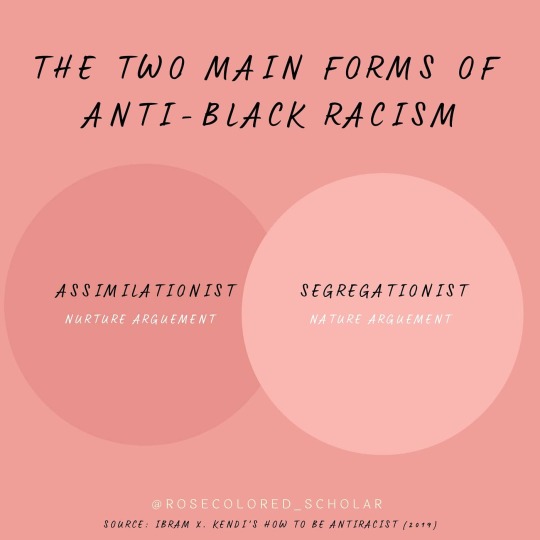
"Southern whites cannot walk, talk, sing, conceive of laws or justice, think of sex, love, the family or freedom without responding to the presence of Negroes." – Ralph Ellison
The problem of holding the Negro down, therefore, is easily solved. When you control a man’s thinking you do not have to worry about his actions. You do not have to tell him not to stand here or go yonder. He will find his “proper place” and will stay in it. You do not need to send him to the back door. He will go without being told. In fact, if there is no back door, he will cut one for his special benefit. – Carter G. Woodson, The Miseducation of the Negro, 1933
-
When we discuss anti-Black racism, it must be noted that we are talking about a very specific root of white supremacy, one that is wholly unique – but still connected – to the anti-indigenous, anti-Muslim, antisemitic movement that infects and affects the [white] Western world.
In the weeds of complexities and intersections, there are two major types of anti-black racism that dominate our public sphere: segregationist and assimilationist.
Segregationist is the school of thought we are most familiar with, in part, because white supremacist violence is both visible and vitriol.
Our minds supply us with images of the Ku Klux Klan and burning crosses, the Nazi sympathizers and defenders of the Lost Cause with confederate flags, the red-faced parents screaming at Ruby Bridges and the Little Rock Nine, and police officers brutalizing Black bodies peacefully protesting in the streets. These images were introduced to the [white] American public during the Civil Rights Movement of the 1950s and 60s on their living room television sets. They are now ingrained into our collective consciousness and we label those actions and images as RACIST. However, those the danger that comes with that system of reality is that it detaches us from the subtle, pervasive, and continuing politics and practices of segregationists’ work. The Klan did not create America's caste system. They merely reinforced it.
To understand segregationist thought, you must understand their historical AND contemporary system of reality.
Southern educator and researcher Thomas Bailey details in his 1914 work Race Orthodoxy in the South the racial credence that was adopted by the majority white Southerners:
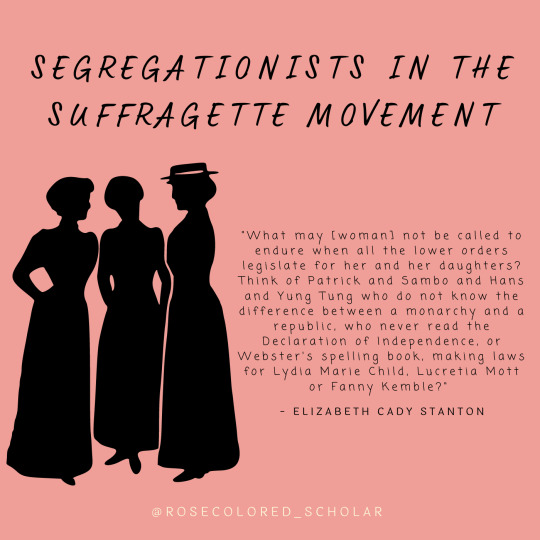
Segregationists believe that Black people are inferior by nature. This idea is based on a multigenerational caste system that places Blacks as intellectually, socially, morally, and physically inferior to those who identify as white (or near white).
1. “Blood will tell.”
2. The white race must dominate.
3. The Teutonic peoples stand for race purity.
4. The negro is inferior and will remain so.
5. “This is a white man’s country.”
6. No social equality.
7. No political equality.
8. In matters of civil rights and legal adjustments give the white man, as opposed to the colored man, the benefit of the doubt; and under no circumstances interfere with the prestige of the white man.
9. In educational policy let the negro have the crumbs that fall from the white man’s table.
10. Let there be such industrial education of the negro as will best fir him to serve the white man.
11. Only [white] Southerners understand the negro question.
12. Let the [white] South settle the negro question.
13. The status of peasantry is all the negro may hope for if the races are to live together in peace.
14. Let the lowest white man count for more than the highest negro.
15. The above statements indicate the leadings of Providence.
(Scholar question: Which of these credence’s do you think still exist in our present-day spaces?)
While we have moved forward since Bailey’s book publication 106 years ago, some of these decrees are uncomfortably familiar . . . we often don’t want to analyze why the South, as a geopolitical region and former secessionist state, was able to enforce white supremacy in every area of public (and private) life nor do we care to examine how these policies set the tone for the rest of the United States in regards to the larger Jim Crow ideology, or Dixie Doctrine.
Dixie Doctrine, as defined in Glenda Gilmore’s massive work Defying Dixie, as the active participation and organization of white supremacists in both the South and nation’s capital who worked to reinforce the racial caste system.
While Jim Crow often exists in the pages of academia as a series of segregationist policies that influenced [white] public spaces, Dixie Doctrine showcases an international, color-coded solution for ever human deed and thought across color and racial lines. White supremacists believed that a racial caste system would spread across the nations – with the white race at the top.
Since the South was not a sovereign nation, Jim Crow’s – and, by extension, Dixie Doctrine’s – health depended on the federal government’s support of its administration and on receptive public opinion or – at least – the complacency of people both within and outside of the South. Scholar Amy Louise Wood notes that “with the final withdrawal of federal troops in the South in 1877, the use of violence to control the black population was practiced without hindrance, as white southerners sought to reverse the changes brought about Reconstruction and to restore the old social order” (Wood 762). The violence and disenfranchisement that covered the Jim Crow era came about, in part, due to the vacuum created by the disruptions and dislocation of the New South:
In this new environment, one’s social status was less known and less fixed and traditional forms of authority—the patriarchal household, the church, the planter elite—were called into question. Moreover, interactions in industrial workplaces and exchanges in the commercial marketplace could potentially place white and blacks on equal footing . . . white southerners reasserted their authority amid these changes through the systematic disenfranchisement of African Americans and the establishment of racial segregation throughout the 1890s. (Wood 764)
Jim Crow took the national stage when Southerner Woodrow Wilson became president in 1913. The first national Congress under his leadership saw no less than 20 bills presented that pushed for Jim Crow legislation in DC. These bills included segregated train cars – or Jim Crow cars – race segregation of federal jobs, racial exclusion from military service, and tougher miscegenation laws. Under his administration, any form of legal or economic justice for Black Southerners (and Black citizens across the United States) was merely a calculated maneuver meant to “make Jim Crow work more smoothly” (Gilmore 19).

Under Woodrow, the United States saw one of the worst decades of anti-Black violence – over 100 Black individuals were lynched, shot, or burned in 1915 alone. Following the 1920s, the Great Depression fueled a whole new way of violence against black Southerners and Westerners who were seen by working-class whites as competitors for labor jobs. Since many Black workers were willing (or forced) to work for lower wages and were barred from unions, they were seen by many industrialists as the perfect workers to exploit for labor, given that their protests were met by overwhelming police force. Black laborers also had to worry about the possibility of being fired for speaking out or protesting given that most Southern states had strict vagrancy laws that targeted unemployed Black men, who were then shuffled into hard labor camps and chain gangs for indeterminate amounts of time.
Employing overworked and underpaid Black workers over white union workers and independent laborers also served to deepen the established racial divide since employment not only guaranteed wages, but also served as a social and economic barometer in the reimagined, industrial age. This resented not only resulted in heightened racial violence, but also squashed any potential interracial efforts to create inclusive unions and strengthen better workers’ rights.
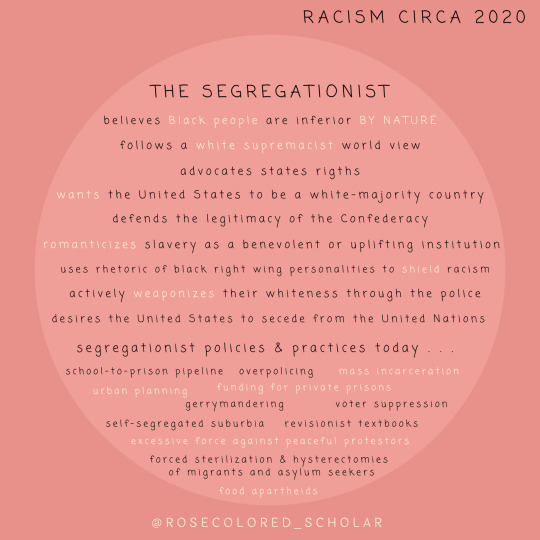
In summary, white segregationists are very concerned with the economic, political, and [spiritual] advancement of Black, brown, and indigenous people. When author Isabel Wilkerson noted in a recent interview that Trumpians were not only voting on issues relating to 2016 (and now 2020) but also the "Race Question" of 2054 (the year when, according to our census, the United States will no longer be a white-majority country).
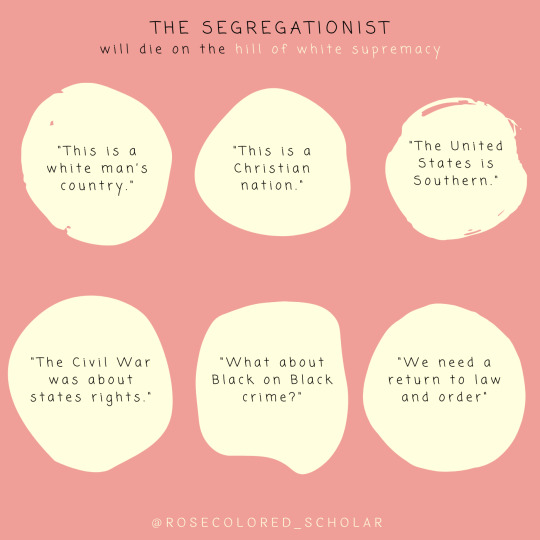
-
The idea of race & caste runs so deeply, and the suggestion that white Americans will no longer be the political and racially dominant group comes from the same place of fear that white Southerners in the 1870s and 1920s used to justify their racial violence and segregationist system of reality . . . .
Join my patreon and follow me on Instagram @rosecolored_scholar
#history#white supremacy#leon litwack#glenda gilmore#padawan historian#antiracist liberation#rosecolored_scholar#segregationists#assimilationists#understanding racism#carter g. woodson#scientific racism#antiracism#black lives matter#politics#woodrow wilson
12 notes
·
View notes
Text
A Different Kind of Fic Rec
So ... you know how there’s good fic, and then there’s next tier fic? Like the kind that blow you out of this world? Ones that change you as a person?
Those are rare gems across different fandoms. They’re just a handful really, but they’re so dense you come out a different person once you finish reading them.
Without further ado ... my favourite next tier fics. Across different fandoms.
Kill Your Heroes || Naruto || 272,492 words || Ongoing It's time to stop waiting for other people to save you. A story about fear, resilience, and Sakura.
** If you love Sakura centric fics, drop everything you’re doing and read this
backslide || Naruto || 128,352 words || Complete Naruto’s friends are gone, his lover is dying, Konoha is destroyed, and Madara’s second return has pushed the entire world to the brink. Hunted and harried, Naruto is sent back in time to upend Madara’s plan before it even starts, and sets about changing everything. Butterfly effect nothing: the world is at stake, and Naruto is hardly about to let it fall to ruin once more. Not while he’s still breathing.
ANBU Legacy || Naruto || Ongoing ** Absolute Favourite of All Time Vol. 1 - Complete - 196,000 words Vol. 2 - Complete - 210,000 words Vol. 3 - Complete - 217,000 words Vol. 4 - Complete - 250,000 words Vol. 5 - Ongoing
ANBU Legacy is a collaborative serial novel based on the world of Naruto by Masashi Kishimoto. It follows an alternate timeline, taking place in a Konoha where the Yondaime defeated the Kyuubi — and lived. Set approximately four years after that event, Legacy is focused on the young men and women of ANBU, who took the vow to defend the Hokage and their village at all costs.
** If you love badass ANBU, team bonding, Kakashi Hatake, Gemna Shiranui, angst, All the Good Gay Shit, you NEED to read this.
A Twist In Time || Naruto || 247,537 words || Complete With Konoha on the verge of destruction, Sakura is sent on a last-resort mission to save her world by travelling to the past. Join her in coping with her old body's shortcomings, testing the natural laws of time, falling in love all over again, and rediscovering who she is. Time-travel. SasuSaku.
** Coming from someone who actually hates SS, this fic is. Mind. Blowing. It’s Sakura-centric and features AMAZING character growth. I think I’ve reread this one 5+ times waiting for updates.
The Lives Worth Saving || Naruto || 134,188 words || Abandoned Naruto, at 26, has lived through 10 years of war. At the end, with nothing left to call home, he sends himself back to the beginning, to the day of his younger self's graduation, in an attempt to change it all. Time travel AU.
** That this fic is abandoned is an absolute tragedy, but it doesn’t stop me from rereading it endlessly.
House of Crows || Naruto || 400,508 words || Complete KakaSaku. War is coming to Konoha and Sakura is far from home, uncertain of her future. But one thing is for sure, Sakura will protect her unborn child at all costs, whether it be from Konoha's enemies... or from its own father.
** This fic is so powerful it sent me into actual depression for like 2 weeks lmao
Pulling My Weight || Naruto || 375,630 words || Ongoing During the mission to Wave, Sakura realises that she has to become a better ninja for her teammates' sake and be someone they can depend on. She vows to take her training seriously, and receives help from the most unlikely of sources; Genma Shiranui. The two form an unlikely bond and stick together through thick and thin, while Sakura improves and meets other people along the way.
** So, so entertaining, but above all so satisfying. I must’ve reread this one 4 or 5 times while waiting for updates.
Will of Fire || Naruto || 223,234 words || Complete Forced to flee their village and the new regime, the loyal shinobi of Konoha must find a way to preserve their way of life and take back their home. As they fight for their future, Team Seven struggles to overcome the past. KakaSaku
Once More, With Feeling || Naruto || 127,462 words || Complete Art enables us to find ourselves and lose ourselves at the same time.
** I read this one a very long time ago but it resonated so deeply (despite being in first person)
Stripped Bare || Naruto || 295,128 words || Complete When Sakura wanted a change of pace, she hadn't expected THIS! Now she's on a mission with Kakashi, masquerading as a dancer at a club far away from home and she finds herself forced to explore her own powers of sexuality and seduction. KakaSaku LEMON
** so IMPACTFUL. This is not a light read by any measure.
Double Edged || Naruto || 347,047 words || Complete Seduction is like a double edged sword. You never know when you'll go from being the seducer to being the seduced. KakaSaku
The Window || Naruto || 165,171 words || Complete Kakasaku Sakura always wanted to see Kakashi unmasked. This was a bit much though...
to memory now I can’t recall || MCU || 102,600 words || Complete While on a mission storming a HYDRA facility, James Buchanan Barnes touches one of the many strange alien devices collected by the Red Skull. He does this, in fact, twice— in the past, and in the future.
Next thing he knows, Bucky Barnes is opening his eyes in the 21st century, which is full of great gadgets and coffee, and at least includes his old pal Steve. (And, inexplicably, a different Stark.) Meanwhile, the Winter Soldier finds himself in the middle of World War Two, helping Captain America hunt down HYDRA (which is at least familiar), pretending to be Bucky Barnes (which is not), and figuring out the very noisy group of soldiers who call themselves the Howling Commandos.
** GOOD SHIT, my dudes. I’ve lose count of how many times I’ve read this once. Definitely more than four times.
The Twice-Told Tale || MCU || 15,789 words || Complete For someone he'd hero-worshipped for so long, Steve Rogers in the flesh is a pretty big disappointment. For one thing, he keeps looking at Tony as though he reminds him of someone else, and even if he never says anything, Tony's pretty sure it's his father. A lifetime of not measuring up to Howard's expectations is more than enough, thank you very much, and he's certainly not going to make an effort to live up to any of Steve's. Steve's pretty clearly failed to live up to his expectations, in any case, and that's not hypocritical at all.
** SUCH an entertaining read. I’ve read this one definitely more than 5+ times.
The Act of Creation Will Be Your Salvation || MCU || 84,678 words || Complete When Tony Stark was seventeen years old, he built his first AI. On that day, he ceased to be his father's creation, and became a creating force in his own right.
That one act likely saved his life, and not always in the most obvious ways.
** This fic will ruin you in the best ways. Worth many, many, many rereads.
The Third Option || MCU || 220,962 words || Complete Homecoming A/U.
Ben and May divorced before Peter’s parents died, so when Ben is murdered Peter goes into foster care. It takes just a tiny taste of superpowers for Peter to decide he doesn’t want to put up with his horrible foster father anymore—the streets are infinitely more appealing. All he wants is to be Spider-Man anyway.
So he leaves.
Simple.
Simple, that is, until Iron Man needs Spider-Man’s help. Peter isn’t about to turn down an opportunity to fight alongside Tony Freaking Stark, but he also isn’t going to let his hero know that his recruit is a fifteen-year-old homeless dropout. So they strike a deal. Peter will help Tony. In return, the mask stays on.
And that’s when things get complicated.
** If you love angst, this is the one for you. Also worth many rereads.
Anew. || MCU || 130,298 words || Complete In death, there was no glory, no redemption, no salvation.
Only darkness and ice—or that was what Tony thought. He closed his eyes in a Siberian bunker and opened them again on his 41st birthday, with War Machine flying into the distance.
a study in scarlette || Case Closed || 214,688 words || Complete There are people who want to live forever, and then there is Shinichi, who just wants to live a little longer than this.
** One of like, my top 10 fics of all time across any fandom.
When Pandora’s Box Is Opened || Case Closed || 299,231 words || Complete After two long years as Conan, the time has finally come for the ancient battle to come to an end, and fate will determine whether the Silver Bullet will survive the shot, unless Shinichi can put his faith in the enemy that was destined to be his ally...
... Yeah I did this because I was bored oops
30 notes
·
View notes
Text
Look Up the word SOCIALISM. Please. It has fuck-all nothing to do with guns.
I ran across this comment:
“I am for gun rights.. does that make me less socialist?”
Are you fucking kidding me? There are really people THIS stupid. This is why America is about to collapse like the Soviet Union did. It’s not because we were outspent like they were, it’s because we’re suffering under TWO pandemics right now- Covid-19 AND TOTAL FUCKERY because far, FAR too many people are just that ignorant.
As a veteran, I was trained to use firearms. They’re tools for hunting and killing. End of story. Want one? I’m all for it! Everyone who’s willing to put in the effort to train and get a license for one should have one if they really want to. I’m all in, hoss.
However, when you’re equating having a killing tool that makes it way too easy to put someone to death with alongside a political style of governance, you’re a fucking idiot. Only in #Murica do people have this issue. By my account, the 2nd Amendment should be shit-canned. It’s outdated and nobody takes it seriously anymore. How so?
“A well regulated militia...”
Let’s stop right there. When this was written, children, there was no standing army in the new USA. At best, each state was, in theory, expected to raise their own militias and even then, they owned their own weapons that they had to buy themselves (and we’re talking the same rifles they also used for hunting with). A British Regular of the time, a professional, well-trained soldier, could fire 3 rounds per minute. A yokel from some Colonial/State militia? One. Maybe two at best. Training was nothing less than lax back then and it was insanely expensive.
To the point- if you want to join a state militia, i.e. the National Guard, then fine; own a gun. In the more modern sense, if you want to join a branch of our fine armed forces, then you’ll train and you can have a gun. No problemo. Once you’re discharged and leave, you can transfer your training creds and easily get a civilian license to own and operate one. Easy-peasy. Right?
But no. Not in #Murica. Here, people no longer read and deteriorated cognitive skills only let too many yokels retain what they want to hear, like NRA talking points on FOX fuckin’ “News”. These selfish cunts are so wound, stupid and bent on being free-range ammosexuals. What the fuck are they afraid of? I’ll tell you.
Smart people.
The whingers on the far right... motherfuckers one and all... with their bibles in one hand and guns in the other... They fail to know what hypocrisy is here. Be that as it may, they’re scared of smart people. They know that more often than not, they’re ability to have an intelligent conversation is rather stilted and smart people can kick their asses when it comes to how politics work, what Jesus actually said in that bible they never read, and how viruses work for that matter. These wank-socks need their guns to make them right in an argument.
To compound things, these knuckle-dragging, inbred, mouth-breathers are mostly a bunch of “nigger haters” and they know that the “Justice” system will continue to jail the Black Community for the most minor infractions, essentially re -instituting slavery while they can literally go into Federal property, armed, take it over, vandalize it, and then leave scott-free. Precedence has been set. They can shoot Black people with little to no repercussions. Precedence has been set.
I could go on and on, but I’d like to bring this question to your attention: What the unholy fuck does that have to do with socialism? Eisenhower was not only a president but he was a general during WWII and his policies were very socialist. By today’s standards, the man would be what right-wing fuckwits would call a “radical leftist”. So would Abraham Lincoln.
Capitalism, as it stands today, un-regulated and un-tethered, has done what for the USA? Massive class warfare and overwhelmingly unfair practices by the top financial elites? Yep. All the rules of olde that were put in place after the Great Depression that were designed to keep that from happening again have been dismantled since Reagan’s time and mostly by the GOP while the Democrats say and do little to nothing about it and they’re only getting more complacent about it. I’m not saying that Capitalism is bad; far from it. However, if it is left to its own devices, it will work like a cancer, not like a working form of governance. No system is perfect, but Capitalism is the most vulnerable, especially in a nation with a base in democracy like the republic that the USA used to have and doesn’t anymore. Once disinterest and complacency set in, the rich and powerful will swipe democracy out from under you like a table cloth without a care as to how many dishes they break or how big the mess will be; you won’t see it coming and you’ll be the one left having to clean up after. The food and drink will be gone along with the silverware, but the mess is all yours to enjoy. You know- like NOW.
Switzerland has a government a lot like ours. It’s a Democratic Republic. “Everyone owns guns!” Um, true to a point. Men do. Women do. BUT. They’re all trained. Come legal age and graduation from high school, you’re in the army, Fred. You do your bit for country and then when you get out, you keep your gun. NO AMMO. Repeat- NO AMMO. That’s all under lock and key where you, as a reservist for life, would go to train periodically.
Chicken-shit fuckwits in #Murica are too fucking scared and/or lazy to join the armed forces or law enforcement. BUT they still want their guns without having to earn the right or privilege. THAT is what pisses me off. No “militia” skills, but boy they’re fast and happy to endanger everyone else just so they can sit out in the woods with their friends, shoot beer cans and have circle-jerks around the ol’ campfire while talking about race cars and titties and swapping jokes about how many “niggers” it takes to do something.

It’s not just a redneck stereotype; it’s the real deal. Those industrial-grade gun fuckers out in Michigan who thought it’d be just fine to “occupy” the capital while armed make the rest of us who earned the right and privilege to have firearms look bad. You also know damn well that there really aren’t BLACK people acting like these infantile taint-barnacles either. You don’t see hordes of women packin’ heat on the way to the clinic for a routine checkup, do you? They ought to, especially when there are anti-abortion fucks out there ranting about shit they know nothing about, spewing their lies by twisting biblical verse when in fact the bible is NOT anti-abortion. It is only mentioned ONCE, and the verse is FOR abortion. Imagine a woman coming in for a pap, palming a .357 on her way through a crowd of these ignorant cultists who think they’re doing “the lord’s work”...
All of this shit isn’t particular to any form of government except for American-style “democracy” where uninformed opinions are now given the same merit and weight as that of a well studied, well informed fact. Anyone who wants to “make America great again” would have noticed that the policies in place that made us a world power to begin with were all backed by SOCIALIST principles, providing a regulated and more fair framework on which the gears of capitalism were attached to run like a smooth, well tuned machine. Today, that framework is shot to pieces and the whole system works more like the junk drawer in your kitchen.
Today, #Murica has a framework made of PLUTOCRACY, welded together with FASCISM and let’s not forget that it is painted in Red Socialism for the Wealthy, White Supremacy, and Blue, sunny-skies of Nationalism that keeps the masses proud of this country because of what we were, not who we truly are. Those days are far gone; days when the NRA was FOR GUN REGULATIONS and were all for proper education, safety and training, in an era where SOCIALISM built our infrastructure, rich fucks were taxed heavily to keep them from gaining too much power over the masses, and we were on the rise in industry, sciences, and education.
Today, smart people are feared, intelligence is out of fashion, and pride in how stupid and ignorant one is has become the national pastime. As a nation, its people are arrogant and endlessly selfish and too stupid to know to punch up when punching down is easier because Americans, in general, are lazy. Even worse, they’re offended by everything while BEING one of the most offensive people to wander the Earth.
Don’t believe me? Keep an eye on the comments to this post...
18 notes
·
View notes
Text
On This Day...
1775 – The Olive Branch Petition, adopted by the Second Continental Congress on July 5, 1775, was signed by members of the Continental Congress. The petition was a final attempt to avoid a full-blown war between the Thirteen Colonies that the Congress represented, and Great Britain. The petition affirmed American loyalty to Great Britain and entreated the king to prevent further conflict. In August 1775 the colonies were formally declared to be in rebellion by the Proclamation of Rebellion, and the petition was rejected in fact, although not having been received by the king before declaring the Congress-supporting colonists traitors. 1776 – In Philadelphia, the Liberty Bell rings out from the tower of the Pennsylvania State House (now known as Independence Hall), summoning citizens to the first public reading of the Declaration of Independence, by Colonel John Nixon. On July 4, the historic document was adopted by delegates to the Continental Congress meeting in the State House. However, the Liberty Bell, which bore the apt biblical quotation, “Proclaim Liberty Throughout All the Land unto All the Inhabitants Thereof,” was not rung until the Declaration of Independence returned from the printer on July 8. In 1751, to commemorate the 50-year anniversary of Pennsylvania’s original constitution, the Pennsylvania Provincial Assembly ordered the 2,000-pound copper and tin bell constructed. After being cracked during a test, and then recast twice, the bell was hung from the State House steeple in June 1753. Rung to call the Pennsylvania Assembly together and to summon people for special announcements and events, it was also rung on important occasions, such as when King George III ascended to the throne in 1761 and to call the people together to discuss Parliament’s controversial Stamp Act of 1765. With the outbreak of the American Revolution in April 1775, the bell was rung to announce the battles of Lexington and Concord. Its most famous tolling was on July 8, 1776, when it summoned Philadelphia citizens for the first reading of the Declaration of Independence. As the British advanced toward Philadelphia in the fall of 1777, the bell was removed from the city and hidden in Allentown to save it from being melted down by the British and used for cannons. After the British defeat in 1781, the bell was returned to Philadelphia, which was the nation’s capital from 1790 to 1800. In addition to marking important events, the bell tolled annually to celebrate George Washington’s birthday on February 22, and Independence Day on July 4. In 1839, the name “Liberty Bell” was first coined in a poem in an abolitionist pamphlet. The question of when the Liberty Bell acquired its famous fracture has been the subject of a good deal of historical dispute. In the most commonly accepted account, the bell suffered a major break while tolling for the funeral of the chief justice of the United States, John Marshall, in 1835, and in 1846 the crack expanded to its present size while in use to mark Washington’s birthday. After that date, it was regarded as unsuitable for ringing, but it was still ceremoniously tapped on occasion to commemorate important events. On June 6, 1944, when Allied forces invaded France, the sound of the bell’s dulled ring was broadcast by radio across the United States. In 1976, the Liberty Bell was moved to a new pavilion about 100 yards from Independence Hall in preparation for America’s bicentennial celebrations. 1778 – George Washington headquartered his Continental Army at West Point. 1918 – Ernest Hemingway is severely wounded while carrying a companion to safety on the Austro-Italian front during World War I. Hemingway, working as a Red Cross ambulance driver, was decorated for his heroism and sent home. Hemingway was born in 1899 in Oak Park, Illinois. Before joining the Red Cross, he worked as a reporter for the Kansas City Star. After the war, he married the wealthy Hadley Richardson. The couple moved to Paris, where they met other American expatriate writers, including F. Scott Fitzgerald, Gertrude Stein, and Ezra Pound. With their help and encouragement, Hemingway published his first book of short stories, in the U.S. in 1925, followed by the well-received The Sun Also Rises in 1926. Hemingway would marry three more times, and his romantic and sporting epics would be followed almost as closely as his writing. During the 1930s and ’40s, the hard-drinking Hemingway lived in Key West and then in Cuba while continuing to travel widely. He wrote The Old Man and the Sea in 1952, his first major literary work in nearly a decade. The book won the Pulitzer Prize in 1953. The same year, Hemingway was wounded in a plane crash, after which he became increasingly anxious and depressed. Like his father, he eventually committed suicide, shooting himself in 1961 in his home in Idaho. (Ernest Hemingway on crutches in 1918, outside the American Red Cross hospital in Milan. The protagonist in his World War I novel, A Farewell to Arms, is an American ambulance driver on the Italian front who was wounded in both legs.)
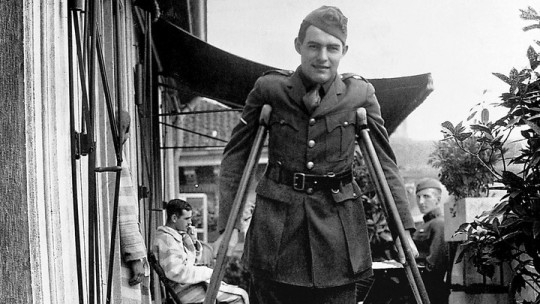
1944 – The US 1st Army is reinforced with 2 divisions arriving from Britain. There is heavy fighting along the road from Carentan to Periers. 1947 – In New Mexico the Roswell Daily Record reported the military’s capture of a flying saucer. It became know as the Roswell Incident. Officials later called the debris a “harmless, high-altitude weather balloon. In 1994 the Air Force released a report saying the wreckage was part of a device used to spy on the Soviets. 1959 – Maj. Dale R. Ruis and Master Sgt. Chester M. Ovnand become the first Americans killed in the American phase of the Vietnam War when guerrillas strike a Military Assistance Advisory Group (MAAG) compound in Bien Hoa, 20 miles northeast of Saigon. The group had arrived in South Vietnam on November 1, 1955, to provide military assistance. The organization consisted of U.S. Army, Navy, Air Force, and Marine Corps personnel who provided advice and assistance to the Ministry of Defense, Joint General Staff, corps and division commanders, training centers, and province and district headquarters. 1960 – The Soviet Union charged Francis Gary Powers, whose U-2 spy plane was shot down over the country, with espionage. 1999 – An Air Force cargo jet took off from Seattle on a dangerous mission to Antarctica to drop medicine for Dr. Jerri Nielsen, a physician at the Amundsen-Scott South Pole Research Center who had discovered a lump in her breast. The mission was successful; Nielsen was evacuated the following October. Congressional Medal of Honor Citations for Actions Taken This Day CARNEY, WILLIAM H. Rank and organization: Sergeant, Company C, 54th Massachusetts Colored Infantry. Place and date: At Fort Wagner, S.C., 18 July 1863. Entered service at: New Bedford, Mass. Birth: Norfolk, Va. Date of issue: 23 May 1900. Citation: When the color sergeant was shot down, this soldier grasped the flag, led the way to the parapet, and planted the colors thereon. When the troops fell back he brought off the flag, under a fierce fire in which he was twice severely wounded.
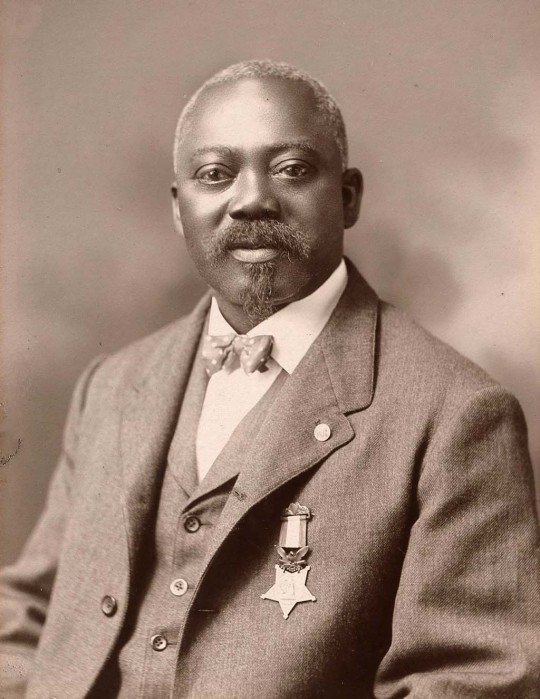
CO-RUX-TE-CHOD-ISH (Mad Bear) Rank and organization: Sergeant, Pawnee Scouts, U.S. Army. Place and date: At Republican River, Kans., 8 July 1869. Entered service at: ——. Birth: Nebraska. Date of issue: 24 August 1869. Citation: Ran out from the command in pursuit of a dismounted Indian; was shot down and badly wounded by a bullet from his own command.
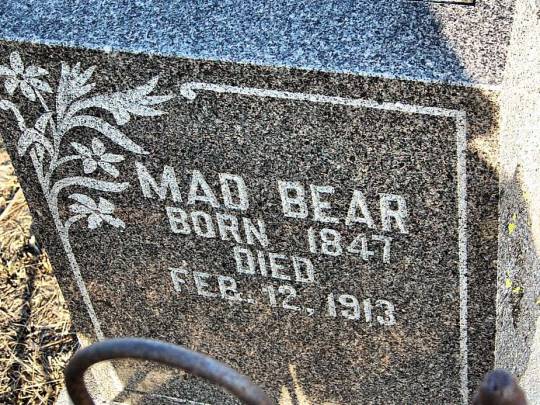
SHEA, RICHARD T., JR. Rank and organization: First Lieutenant, U.S. Army, Company A 17th Infantry Regiment, 7th Infantry Division. Place and date: Near Sokkogae, Korea, 6 to 8 July 1953. Entered service at: Portsmouth, Va. Born: 3 January 1927, Portsmouth, Va. G.O. No.: 38, 8 June 1955. Citation: 1st Lt. Shea, executive officer, Company A, distinguished himself by conspicuous gallantry and indomitable courage above and beyond the call of duty in action against the enemy. On the night of 6 July, he was supervising the reinforcement of defensive positions when the enemy attacked with great numerical superiority. Voluntarily proceeding to the area most threatened, he organized and led a counterattack and, in the bitter fighting which ensued, closed with and killed 2 hostile soldiers with his trench knife. Calmly moving among the men, checking positions, steadying and urging the troops to hold firm, he fought side by side with them throughout the night. Despite heavy losses, the hostile force pressed the assault with determination, and at dawn made an all-out attempt to overrun friendly elements. Charging forward to meet the challenge, 1st Lt. Shea and his gallant men drove back the hostile troops. Elements of Company G joined the defense on the afternoon of 7 July, having lost key personnel through casualties. Immediately integrating these troops into his unit, 1st Lt. Shea rallied a group of 20 men and again charged the enemy. Although wounded in this action, he refused evacuation and continued to lead the counterattack. When the assaulting element was pinned down by heavy machine gun fire, he personally rushed the emplacement and, firing his carbine and lobbing grenades with deadly accuracy, neutralized the weapon and killed 3 of the enemy. With forceful leadership and by his heroic example, 1st Lt. Shea coordinated and directed a holding action throughout the night and the following morning. On 8 July, the enemy attacked again. Despite additional wounds, he launched a determined counterattack and was last seen in close hand-to-hand combat with the enemy. 1st Lt. Shea’s inspirational leadership and unflinching courage set an illustrious example of valor to the men of his regiment, reflecting lasting glory upon himself and upholding the noble traditions of the military service.

SOURCE
10 notes
·
View notes
Photo



Redlining in America Part 2: Assessment
This is Part 2 of a 3-part series on the history of redlining in America. If you’ve not read Part 1 yet, start there as it goes over the government agencies that will be discussed in this post — Redlining in America - Part 1: The Origin of Redlining
As discussed briefly in the previous post, the Home Owners’ Loan Corporation (HOLC) and Federal Housing Administration (FHA) each used assessment methods to judge the perceived risk of investing in properties. The degree of safety vs. risk a property was judged to have by these agencies, from an investment standpoint, would decide if a mortgage was saved from foreclosure (HOLC) or if the government would insure a new mortgage (FHA). These assessments would make or break a family’s attempts to become homeowners or avoid loosing their home during the Great Depression.
HOLC Maps
These were colour-coded maps, made for every metropolitan area in the US. It used colour blocks to mark our the perceived investment risk of neighbourhoods using a 4-colour range.
Green — Grade A — “In Demand”
Blue — Grade B — “Still Desirable”
Yellow — Grade C — “Declining”
Red — Grade D — “High Risk/Hazardous”
While in theory this may make sense to some degree, the way these divisions were made is the issue. While matters like building quality or age, cost, population growth, and proportion of homeownership vs. renting; it is inescapable that a significant portion of the assessment was based on the ‘racial’ and economic make-up of the neighbourhood. In the HOLC’s own words, their assessment judged the “threat of infiltration of foreign-born, negro, or lower grade population.” The very wording of the paperwork is discriminatory, with terms like “unskilled labor-merchants questionable characters,” “Foreign-born families...%,” and most tellingly “Infiltration of...” which pertained to groups such as “Italians & Negro”.
The weight of “undesirable” ethnic groups on a rating can be seen in how they are spread over the grades. To qualify for a Green (Grade A) rating, a neighbourhood would have to be void of “a single foreigner or Negro.” Spatially, there were often the newer-built suburbs. Surrounding areas with older suburbs would then be rated as Blue (Grade B), as they became closer to the city centre and more mixed with a small number of the “undesirable” populations. Yellow (Grade C) neighbourhoods would often be those bordering the Red (Grade D) ones. They would have older buildings and were considered to be in “transition” and decline. Finally those in the Red grading would typically be inner-city neighbourhoods surrounding the central business district of a city. These would be neighbourhoods with predominantly Black, foreign and working-class occupants.
The University of Richmond offers an amazing interactive map of neighbourhoods using scanned HOLC maps and links them to the official HOLC paperwork relating to each. I recommend taking a look and reading the documents that accompany various graded neighbourhoods.
FHA’s Underwriting Manual
From 1935, the FHA provided their appraisers with an instructional document called the Underwriting Manual that outlined how they wanted properties to be rated. The text of this document carries a clear racial agenda: "If a neighborhood is to retain stability it is necessary that properties shall continue to be occupied by the same social and racial classes. A change in social or racial occupancy generally leads to instability and a reduction of values," and "incompatible racial groups should not be permitted to live in the same communities."
The zoning approach was comparable to the HOLC’s colour-coded maps. The manual directed appraisers to issue value based on strict criteria, of which 40% was weighted on “Relative economic Stability” (the economic and employment status of the neighbourhood’s occupants, eg “laborer”), and a further 20% on “protection from adverse influence” (these could include: nearby businesses, schools, or “offensive noises or odors,” element common in inner-city neighbourhoods). The assessments were harshly issued, with some criteria resulting in an automatic rejection. Overall, many of the criteria were inherently prejudice against the urban setting, with elements that were rated being impossible to achieve in an urban setting, like “natural light and ventilation,” and “proximity to joining buildings.”
The FHA used its position as an insurance provider to discourage banks from issuing loans to urban neighbourhoods. This did not affect only homeownership, but also businesses within these communities.
Continue Reading...
This is just the bare-bones basics of redlining and how it was assessed, the previous post in the series addresses the origins of these agencies and policies, while the next will go into the destructive results of the polices on urban setting in the decades that followed and how the perpetuated structural racism in America.
Redlining in America - Part 1: The Origin of Redlining
Redlining in America - Part 3: Discrimination and Damage
Useful Resources
BOOK Rothstein, R. (2018) The Color of Law: A Forgotten History of How Our Government Segregated America. New York: Liveright Publishing Corporation. — This was probably the single most useful book I used during research.
WEBSITE New America: The History of U.S. Housing Segregation Points to the Devastating Consequences of Algorithmic Bias — The material is pretty heavy technically, but had great info on assessment criteria.
PDF A scanned copy of the full FHA Underwriting Manual
My Research Notes
Image Sources
Dual HOLC Map of Brooklyn, 1938 / Current Overlay | Source Cover of FHA Underwriting Manual, 1938 | Source FHA Underwriting Manual fold-out form, 1938 | Source

This post has been sponsored by my much loved and long-time Patreon supporter Joanna Daniels. She and I would like to dedicate the post to the loving memory of her mother Joan Daniels. She will be sorely missed.

[ Support SRNY through Patreon and Ko-Fi ] And join us on Discord for fun conversation! I also have an Etsy with upcycled nerdy crafts
#Steve Rogers#Redlining#American History#Black History#Urban History#History#Structural Racism#structural violence#1930s#New York#New York History#FHA#HOLC#Roosevelt#historically accurate#fanfiction#fanfic#fanfic writing#Fanfic references#fanfic research#writing#writing resources#fan fic writing#writing reference#captain america#Captain America: The First Avenger#captain america tfa#CAPTAIN AMERICA REFERENCE#Bucky Barnes
12 notes
·
View notes